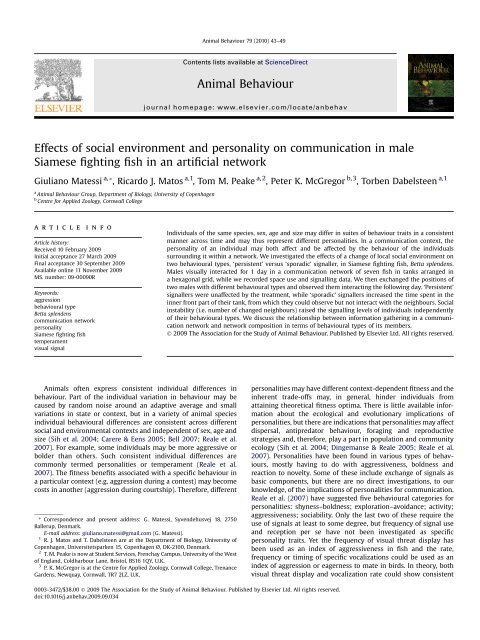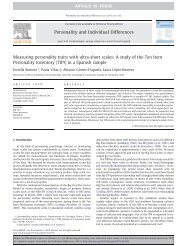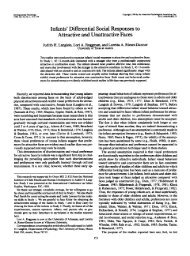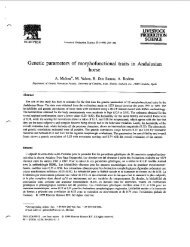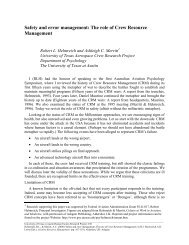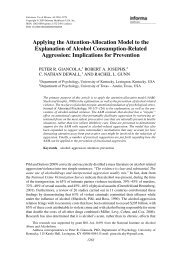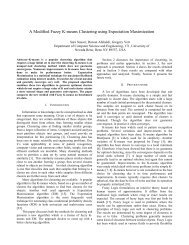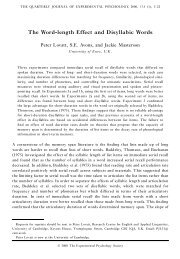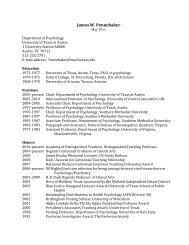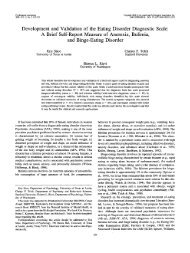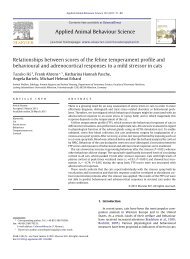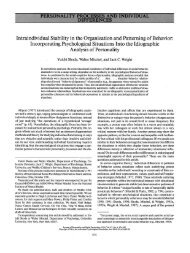Effects of social environment and personality on communication in ...
Effects of social environment and personality on communication in ...
Effects of social environment and personality on communication in ...
You also want an ePaper? Increase the reach of your titles
YUMPU automatically turns print PDFs into web optimized ePapers that Google loves.
<str<strong>on</strong>g>Effects</str<strong>on</strong>g> <str<strong>on</strong>g>of</str<strong>on</strong>g> <str<strong>on</strong>g>social</str<strong>on</strong>g> <str<strong>on</strong>g>envir<strong>on</strong>ment</str<strong>on</strong>g> <str<strong>on</strong>g>and</str<strong>on</strong>g> <str<strong>on</strong>g>pers<strong>on</strong>ality</str<strong>on</strong>g> <strong>on</strong> communicati<strong>on</strong> <strong>in</strong> male<br />
Siamese fight<strong>in</strong>g fish <strong>in</strong> an artificial network<br />
Giuliano Matessi a, *, Ricardo J. Matos a,1 , Tom M. Peake a,2 , Peter K. McGregor b,3 , Torben Dabelsteen a,1<br />
a<br />
Animal Behaviour Group, Department <str<strong>on</strong>g>of</str<strong>on</strong>g> Biology, University <str<strong>on</strong>g>of</str<strong>on</strong>g> Copenhagen<br />
b<br />
Centre for Applied Zoology, Cornwall College<br />
article <strong>in</strong>fo<br />
Article history:<br />
Received 10 February 2009<br />
Initial acceptance 27 March 2009<br />
F<strong>in</strong>al acceptance 30 September 2009<br />
Available <strong>on</strong>l<strong>in</strong>e 11 November 2009<br />
MS. number: 09-00090R<br />
Keywords:<br />
aggressi<strong>on</strong><br />
behavioural type<br />
Betta splendens<br />
communicati<strong>on</strong> network<br />
<str<strong>on</strong>g>pers<strong>on</strong>ality</str<strong>on</strong>g><br />
Siamese fight<strong>in</strong>g fish<br />
temperament<br />
visual signal<br />
Animals <str<strong>on</strong>g>of</str<strong>on</strong>g>ten express c<strong>on</strong>sistent <strong>in</strong>dividual differences <strong>in</strong><br />
behaviour. Part <str<strong>on</strong>g>of</str<strong>on</strong>g> the <strong>in</strong>dividual variati<strong>on</strong> <strong>in</strong> behaviour may be<br />
caused by r<str<strong>on</strong>g>and</str<strong>on</strong>g>om noise around an adaptive average <str<strong>on</strong>g>and</str<strong>on</strong>g> small<br />
variati<strong>on</strong>s <strong>in</strong> state or c<strong>on</strong>text, but <strong>in</strong> a variety <str<strong>on</strong>g>of</str<strong>on</strong>g> animal species<br />
<strong>in</strong>dividual behavioural differences are c<strong>on</strong>sistent across different<br />
<str<strong>on</strong>g>social</str<strong>on</strong>g> <str<strong>on</strong>g>and</str<strong>on</strong>g> <str<strong>on</strong>g>envir<strong>on</strong>ment</str<strong>on</strong>g>al c<strong>on</strong>texts <str<strong>on</strong>g>and</str<strong>on</strong>g> <strong>in</strong>dependent <str<strong>on</strong>g>of</str<strong>on</strong>g> sex, age <str<strong>on</strong>g>and</str<strong>on</strong>g><br />
size (Sih et al. 2004; Carere & Eens 2005; Bell 2007; Reale et al.<br />
2007). For example, some <strong>in</strong>dividuals may be more aggressive or<br />
bolder than others. Such c<strong>on</strong>sistent <strong>in</strong>dividual differences are<br />
comm<strong>on</strong>ly termed pers<strong>on</strong>alities or temperament (Reale et al.<br />
2007). The fitness benefits associated with a specific behaviour <strong>in</strong><br />
a particular c<strong>on</strong>text (e.g. aggressi<strong>on</strong> dur<strong>in</strong>g a c<strong>on</strong>test) may become<br />
costs <strong>in</strong> another (aggressi<strong>on</strong> dur<strong>in</strong>g courtship). Therefore, different<br />
* Corresp<strong>on</strong>dence <str<strong>on</strong>g>and</str<strong>on</strong>g> present address: G. Matessi, Syvendehusvej 18, 2750<br />
Ballerup, Denmark.<br />
E-mail address: giuliano.matessi@gmail.com (G. Matessi).<br />
1<br />
R. J. Matos <str<strong>on</strong>g>and</str<strong>on</strong>g> T. Dabelsteen are at the Department <str<strong>on</strong>g>of</str<strong>on</strong>g> Biology, University <str<strong>on</strong>g>of</str<strong>on</strong>g><br />
Copenhagen, Universitetsparken 15, Copenhagen Ø, DK-2100, Denmark.<br />
2<br />
T. M. Peake is now at Student Services, Frenchay Campus, University <str<strong>on</strong>g>of</str<strong>on</strong>g> the West<br />
<str<strong>on</strong>g>of</str<strong>on</strong>g> Engl<str<strong>on</strong>g>and</str<strong>on</strong>g>, Coldharbour Lane, Bristol, BS16 1QY, U.K.<br />
3<br />
P. K. McGregor is at the Centre for Applied Zoology, Cornwall College, Trenance<br />
Gardens, Newquay, Cornwall, TR7 2LZ, U.K.<br />
Animal Behaviour 79 (2010) 43–49<br />
C<strong>on</strong>tents lists available at ScienceDirect<br />
Animal Behaviour<br />
journal homepage: www.elsevier.com/locate/anbehav<br />
Individuals <str<strong>on</strong>g>of</str<strong>on</strong>g> the same species, sex, age <str<strong>on</strong>g>and</str<strong>on</strong>g> size may differ <strong>in</strong> suites <str<strong>on</strong>g>of</str<strong>on</strong>g> behaviour traits <strong>in</strong> a c<strong>on</strong>sistent<br />
manner across time <str<strong>on</strong>g>and</str<strong>on</strong>g> may thus represent different pers<strong>on</strong>alities. In a communicati<strong>on</strong> c<strong>on</strong>text, the<br />
<str<strong>on</strong>g>pers<strong>on</strong>ality</str<strong>on</strong>g> <str<strong>on</strong>g>of</str<strong>on</strong>g> an <strong>in</strong>dividual may both affect <str<strong>on</strong>g>and</str<strong>on</strong>g> be affected by the behaviour <str<strong>on</strong>g>of</str<strong>on</strong>g> the <strong>in</strong>dividuals<br />
surround<strong>in</strong>g it with<strong>in</strong> a network. We <strong>in</strong>vestigated the effects <str<strong>on</strong>g>of</str<strong>on</strong>g> a change <str<strong>on</strong>g>of</str<strong>on</strong>g> local <str<strong>on</strong>g>social</str<strong>on</strong>g> <str<strong>on</strong>g>envir<strong>on</strong>ment</str<strong>on</strong>g> <strong>on</strong><br />
two behavioural types, ‘persistent’ versus ‘sporadic’ signaller, <strong>in</strong> Siamese fight<strong>in</strong>g fish, Betta splendens.<br />
Males visually <strong>in</strong>teracted for 1 day <strong>in</strong> a communicati<strong>on</strong> network <str<strong>on</strong>g>of</str<strong>on</strong>g> seven fish <strong>in</strong> tanks arranged <strong>in</strong><br />
a hexag<strong>on</strong>al grid, while we recorded space use <str<strong>on</strong>g>and</str<strong>on</strong>g> signall<strong>in</strong>g data. We then exchanged the positi<strong>on</strong>s <str<strong>on</strong>g>of</str<strong>on</strong>g><br />
two males with different behavioural types <str<strong>on</strong>g>and</str<strong>on</strong>g> observed them <strong>in</strong>teract<strong>in</strong>g the follow<strong>in</strong>g day. ‘Persistent’<br />
signallers were unaffected by the treatment, while ‘sporadic’ signallers <strong>in</strong>creased the time spent <strong>in</strong> the<br />
<strong>in</strong>ner fr<strong>on</strong>t part <str<strong>on</strong>g>of</str<strong>on</strong>g> their tank, from which they could observe but not <strong>in</strong>teract with the neighbours. Social<br />
<strong>in</strong>stability (i.e. number <str<strong>on</strong>g>of</str<strong>on</strong>g> changed neighbours) raised the signall<strong>in</strong>g levels <str<strong>on</strong>g>of</str<strong>on</strong>g> <strong>in</strong>dividuals <strong>in</strong>dependently<br />
<str<strong>on</strong>g>of</str<strong>on</strong>g> their behavioural types. We discuss the relati<strong>on</strong>ship between <strong>in</strong>formati<strong>on</strong> gather<strong>in</strong>g <strong>in</strong> a communicati<strong>on</strong><br />
network <str<strong>on</strong>g>and</str<strong>on</strong>g> network compositi<strong>on</strong> <strong>in</strong> terms <str<strong>on</strong>g>of</str<strong>on</strong>g> behavioural types <str<strong>on</strong>g>of</str<strong>on</strong>g> its members.<br />
Ó 2009 The Associati<strong>on</strong> for the Study <str<strong>on</strong>g>of</str<strong>on</strong>g> Animal Behaviour. Published by Elsevier Ltd. All rights reserved.<br />
0003-3472/$38.00 Ó 2009 The Associati<strong>on</strong> for the Study <str<strong>on</strong>g>of</str<strong>on</strong>g> Animal Behaviour. Published by Elsevier Ltd. All rights reserved.<br />
doi:10.1016/j.anbehav.2009.09.034<br />
pers<strong>on</strong>alities may have different c<strong>on</strong>text-dependent fitness <str<strong>on</strong>g>and</str<strong>on</strong>g> the<br />
<strong>in</strong>herent trade-<str<strong>on</strong>g>of</str<strong>on</strong>g>fs may, <strong>in</strong> general, h<strong>in</strong>der <strong>in</strong>dividuals from<br />
atta<strong>in</strong><strong>in</strong>g theoretical fitness optima. There is little available <strong>in</strong>formati<strong>on</strong><br />
about the ecological <str<strong>on</strong>g>and</str<strong>on</strong>g> evoluti<strong>on</strong>ary implicati<strong>on</strong>s <str<strong>on</strong>g>of</str<strong>on</strong>g><br />
pers<strong>on</strong>alities, but there are <strong>in</strong>dicati<strong>on</strong>s that pers<strong>on</strong>alities may affect<br />
dispersal, antipredator behaviour, forag<strong>in</strong>g <str<strong>on</strong>g>and</str<strong>on</strong>g> reproductive<br />
strategies <str<strong>on</strong>g>and</str<strong>on</strong>g>, therefore, play a part <strong>in</strong> populati<strong>on</strong> <str<strong>on</strong>g>and</str<strong>on</strong>g> community<br />
ecology (Sih et al. 2004; D<strong>in</strong>gemanse & Reale 2005; Reale et al.<br />
2007). Pers<strong>on</strong>alities have been found <strong>in</strong> various types <str<strong>on</strong>g>of</str<strong>on</strong>g> behaviours,<br />
mostly hav<strong>in</strong>g to do with aggressiveness, boldness <str<strong>on</strong>g>and</str<strong>on</strong>g><br />
reacti<strong>on</strong> to novelty. Some <str<strong>on</strong>g>of</str<strong>on</strong>g> these <strong>in</strong>clude exchange <str<strong>on</strong>g>of</str<strong>on</strong>g> signals as<br />
basic comp<strong>on</strong>ents, but there are no direct <strong>in</strong>vestigati<strong>on</strong>s, to our<br />
knowledge, <str<strong>on</strong>g>of</str<strong>on</strong>g> the implicati<strong>on</strong>s <str<strong>on</strong>g>of</str<strong>on</strong>g> pers<strong>on</strong>alities for communicati<strong>on</strong>.<br />
Reale et al. (2007) have suggested five behavioural categories for<br />
pers<strong>on</strong>alities: shyness–boldness; explorati<strong>on</strong>–avoidance; activity;<br />
aggressiveness; sociability. Only the last two <str<strong>on</strong>g>of</str<strong>on</strong>g> these require the<br />
use <str<strong>on</strong>g>of</str<strong>on</strong>g> signals at least to some degree, but frequency <str<strong>on</strong>g>of</str<strong>on</strong>g> signal use<br />
<str<strong>on</strong>g>and</str<strong>on</strong>g> recepti<strong>on</strong> per se have not been <strong>in</strong>vestigated as specific<br />
<str<strong>on</strong>g>pers<strong>on</strong>ality</str<strong>on</strong>g> traits. Yet the frequency <str<strong>on</strong>g>of</str<strong>on</strong>g> visual threat display has<br />
been used as an <strong>in</strong>dex <str<strong>on</strong>g>of</str<strong>on</strong>g> aggressiveness <strong>in</strong> fish <str<strong>on</strong>g>and</str<strong>on</strong>g> the rate,<br />
frequency or tim<strong>in</strong>g <str<strong>on</strong>g>of</str<strong>on</strong>g> specific vocalizati<strong>on</strong>s could be used as an<br />
<strong>in</strong>dex <str<strong>on</strong>g>of</str<strong>on</strong>g> aggressi<strong>on</strong> or eagerness to mate <strong>in</strong> birds. In theory, both<br />
visual threat display <str<strong>on</strong>g>and</str<strong>on</strong>g> vocalizati<strong>on</strong> rate could show c<strong>on</strong>sistent
44<br />
<strong>in</strong>dividual variati<strong>on</strong> <str<strong>on</strong>g>and</str<strong>on</strong>g> have different costs <str<strong>on</strong>g>and</str<strong>on</strong>g> benefits <strong>in</strong><br />
different c<strong>on</strong>texts, for example when the same signals are used as<br />
threats to rivals as opposed to potential mates, or as courtship as<br />
opposed to territorial vocalizati<strong>on</strong>s.<br />
Many animals are to some degree <str<strong>on</strong>g>social</str<strong>on</strong>g> <str<strong>on</strong>g>and</str<strong>on</strong>g> even those liv<strong>in</strong>g <strong>in</strong><br />
s<strong>in</strong>gle <strong>in</strong>dividual territories will <strong>in</strong>teract with <str<strong>on</strong>g>and</str<strong>on</strong>g> be affected by<br />
neighbours. There is as yet little <strong>in</strong>formati<strong>on</strong> <strong>on</strong> how the <str<strong>on</strong>g>social</str<strong>on</strong>g><br />
<str<strong>on</strong>g>envir<strong>on</strong>ment</str<strong>on</strong>g> affects <strong>in</strong>dividual differences <strong>in</strong> behaviour (van Oers<br />
et al. 2005; Cr<str<strong>on</strong>g>of</str<strong>on</strong>g>t et al. 2006; Magnhagen 2007). For example, the<br />
relati<strong>on</strong>ship between exploratory <str<strong>on</strong>g>and</str<strong>on</strong>g> risk-tak<strong>in</strong>g behaviours, two<br />
comm<strong>on</strong> <str<strong>on</strong>g>pers<strong>on</strong>ality</str<strong>on</strong>g> axes, seems to vary accord<strong>in</strong>g to the <str<strong>on</strong>g>social</str<strong>on</strong>g><br />
c<strong>on</strong>text <strong>in</strong> perch, Perca fluviatilis, great tits, Parus major, <str<strong>on</strong>g>and</str<strong>on</strong>g> ravens,<br />
Corvus corax. In great tits risk-tak<strong>in</strong>g behaviour <str<strong>on</strong>g>of</str<strong>on</strong>g> females <str<strong>on</strong>g>and</str<strong>on</strong>g><br />
‘slow’ males was more affected by the presence <str<strong>on</strong>g>of</str<strong>on</strong>g> a compani<strong>on</strong><br />
dur<strong>in</strong>g a forag<strong>in</strong>g task than was that <str<strong>on</strong>g>of</str<strong>on</strong>g> ‘fast’ males (van Oers et al.<br />
2005). Similar effects <str<strong>on</strong>g>of</str<strong>on</strong>g> gender, <str<strong>on</strong>g>social</str<strong>on</strong>g>ity <str<strong>on</strong>g>and</str<strong>on</strong>g> relatedness <strong>on</strong> novel<br />
object explorati<strong>on</strong> were found <strong>in</strong> h<str<strong>on</strong>g>and</str<strong>on</strong>g>-raised ravens (Stöwe et al.<br />
2006; Stöwe & Kotrschal 2007). In <strong>in</strong>dividual young perch the<br />
correlati<strong>on</strong> between risk tak<strong>in</strong>g <str<strong>on</strong>g>and</str<strong>on</strong>g> explorati<strong>on</strong> was dependent <strong>on</strong><br />
the pers<strong>on</strong>alities <str<strong>on</strong>g>of</str<strong>on</strong>g> the other members <str<strong>on</strong>g>of</str<strong>on</strong>g> the group <str<strong>on</strong>g>of</str<strong>on</strong>g> four <strong>in</strong><br />
which they were tested (Magnhagen 2007). In water striders,<br />
Aquarius remigis, group dynamics <str<strong>on</strong>g>and</str<strong>on</strong>g> <strong>in</strong>dividual mat<strong>in</strong>g activity<br />
were str<strong>on</strong>gly affected by group compositi<strong>on</strong> <strong>in</strong> terms <str<strong>on</strong>g>of</str<strong>on</strong>g> behavioural<br />
types: very aggressive males chased <str<strong>on</strong>g>of</str<strong>on</strong>g>f females <str<strong>on</strong>g>and</str<strong>on</strong>g> thus<br />
lowered group mat<strong>in</strong>g frequency (Sih & Watters 2005). Prim<strong>in</strong>g by<br />
earlier <strong>in</strong>teracti<strong>on</strong>s with c<strong>on</strong>specifics will also affect the expressi<strong>on</strong><br />
<str<strong>on</strong>g>of</str<strong>on</strong>g> behaviours normally l<strong>in</strong>ked with pers<strong>on</strong>alities, such as aggressi<strong>on</strong><br />
<str<strong>on</strong>g>and</str<strong>on</strong>g> boldness (Oliveira et al. 2001). The dependence <str<strong>on</strong>g>of</str<strong>on</strong>g> an<br />
<strong>in</strong>dividual’s behaviour <strong>on</strong> what others do is especially obvious <strong>in</strong><br />
communicati<strong>on</strong>, where the signall<strong>in</strong>g level <str<strong>on</strong>g>of</str<strong>on</strong>g> <strong>on</strong>e <strong>in</strong>dividual <strong>in</strong> an<br />
<strong>in</strong>teracti<strong>on</strong> c<strong>on</strong>diti<strong>on</strong>s the signall<strong>in</strong>g level <str<strong>on</strong>g>of</str<strong>on</strong>g> the other (e.g. overlapp<strong>in</strong>g<br />
<str<strong>on</strong>g>and</str<strong>on</strong>g> alternat<strong>in</strong>g or s<strong>on</strong>g type switch<strong>in</strong>g <str<strong>on</strong>g>and</str<strong>on</strong>g> match<strong>in</strong>g <strong>in</strong><br />
great tits; Peake et al. 2005). In communicati<strong>on</strong> networks an <strong>in</strong>dividual’s<br />
signall<strong>in</strong>g behaviour will be affected by the <strong>in</strong>dividuals it is<br />
directly <strong>in</strong>teract<strong>in</strong>g with, but also by the presence <str<strong>on</strong>g>and</str<strong>on</strong>g> signall<strong>in</strong>g<br />
behaviour <str<strong>on</strong>g>of</str<strong>on</strong>g> byst<str<strong>on</strong>g>and</str<strong>on</strong>g>ers, which could be potential eavesdroppers<br />
(Doutrelant & McGregor 2000; Doutrelant et al. 2001; Dabelsteen<br />
2005; Matos & Schlupp 2005; Peake 2005; Matessi et al. 2008).<br />
Individuals may, for example, vary <strong>in</strong> their <strong>in</strong>formati<strong>on</strong>-gather<strong>in</strong>g<br />
<str<strong>on</strong>g>and</str<strong>on</strong>g> resp<strong>on</strong>se strategies, <str<strong>on</strong>g>and</str<strong>on</strong>g> this may be expressed <strong>in</strong> their<br />
eavesdropp<strong>in</strong>g behaviour as well as <strong>in</strong> their better studied exploratory<br />
behaviour (e.g. McGregor & Dabelsteen 1996; Groothuis &<br />
Carere 2005).<br />
Siamese fight<strong>in</strong>g fish, Betta splendens, show c<strong>on</strong>sistent <strong>in</strong>dividual<br />
differences <strong>in</strong> aggressiveness, expressed through signall<strong>in</strong>g<br />
by gill cover erecti<strong>on</strong> or lateral displays <str<strong>on</strong>g>and</str<strong>on</strong>g> through direct c<strong>on</strong>tact<br />
by tail beats <str<strong>on</strong>g>and</str<strong>on</strong>g> bites. These differences also have measurable<br />
c<strong>on</strong>sequences <strong>on</strong> the movement patterns, especially approach <str<strong>on</strong>g>of</str<strong>on</strong>g><br />
c<strong>on</strong>specific neighbours. Time spent near a neighbour was c<strong>on</strong>sistent<br />
over l<strong>on</strong>g periods <str<strong>on</strong>g>of</str<strong>on</strong>g> time <str<strong>on</strong>g>and</str<strong>on</strong>g> predicted the outcome <str<strong>on</strong>g>of</str<strong>on</strong>g> direct<br />
c<strong>on</strong>tests <strong>in</strong> a series <str<strong>on</strong>g>of</str<strong>on</strong>g> laboratory experiments <strong>on</strong> male–male<br />
<strong>in</strong>teracti<strong>on</strong>s (Br<strong>on</strong>ste<strong>in</strong> 1994). In pilot experiments with artificial<br />
communicati<strong>on</strong> networks <str<strong>on</strong>g>of</str<strong>on</strong>g> seven fish we had observed c<strong>on</strong>sistent<br />
differences between <strong>in</strong>dividuals <strong>in</strong> signall<strong>in</strong>g <str<strong>on</strong>g>and</str<strong>on</strong>g> movement<br />
patterns which were stable over 3 days <str<strong>on</strong>g>of</str<strong>on</strong>g> test<strong>in</strong>g. Some <strong>in</strong>dividuals<br />
seemed to spend most <str<strong>on</strong>g>of</str<strong>on</strong>g> their time patroll<strong>in</strong>g <str<strong>on</strong>g>and</str<strong>on</strong>g> signall<strong>in</strong>g<br />
aggressively al<strong>on</strong>g the borders with their three neighbours, while<br />
others alternated <strong>in</strong>tense signall<strong>in</strong>g periods al<strong>on</strong>g the borders with<br />
less active periods away from neighbours, but generally not hid<strong>in</strong>g.<br />
All networks c<strong>on</strong>ta<strong>in</strong>ed a mixture <str<strong>on</strong>g>of</str<strong>on</strong>g> the two behavioural types (R. J.<br />
Matos, T. Peake & G. Matessi, unpublished data). The differences <strong>in</strong><br />
aggressive signall<strong>in</strong>g may reflect <str<strong>on</strong>g>pers<strong>on</strong>ality</str<strong>on</strong>g> types, alternative<br />
signall<strong>in</strong>g or fight<strong>in</strong>g tactics, or may be an expressi<strong>on</strong> <str<strong>on</strong>g>of</str<strong>on</strong>g> alternative<br />
mat<strong>in</strong>g strategies. S<strong>in</strong>ce we could not f<strong>in</strong>d any published reference<br />
to functi<strong>on</strong>al explanati<strong>on</strong>s for these differences <strong>in</strong> behaviour, we<br />
G. Matessi et al. / Animal Behaviour 79 (2010) 43–49<br />
chose to address them as pers<strong>on</strong>alities. The different pers<strong>on</strong>alities<br />
may be <strong>in</strong>fluenced by the <str<strong>on</strong>g>social</str<strong>on</strong>g> <str<strong>on</strong>g>envir<strong>on</strong>ment</str<strong>on</strong>g>, s<strong>in</strong>ce fight<strong>in</strong>g fish<br />
males will resp<strong>on</strong>d to some degree to the level <str<strong>on</strong>g>of</str<strong>on</strong>g> aggressive signall<strong>in</strong>g<br />
received from neighbours (Br<strong>on</strong>ste<strong>in</strong> 1994). We quantified<br />
<str<strong>on</strong>g>and</str<strong>on</strong>g> compared these <strong>in</strong>dividual differences <strong>in</strong> fight<strong>in</strong>g fish behaviour<br />
<strong>in</strong> a network <str<strong>on</strong>g>and</str<strong>on</strong>g> tested the effects <str<strong>on</strong>g>of</str<strong>on</strong>g> <str<strong>on</strong>g>social</str<strong>on</strong>g> <str<strong>on</strong>g>envir<strong>on</strong>ment</str<strong>on</strong>g> <strong>on</strong><br />
<strong>in</strong>dividual variati<strong>on</strong> <strong>in</strong> movement patterns <str<strong>on</strong>g>and</str<strong>on</strong>g> signall<strong>in</strong>g. If<br />
fight<strong>in</strong>g fish vary <strong>in</strong> <str<strong>on</strong>g>pers<strong>on</strong>ality</str<strong>on</strong>g> then: (1) <strong>in</strong>dividuals with<strong>in</strong><br />
a <str<strong>on</strong>g>pers<strong>on</strong>ality</str<strong>on</strong>g> type will resemble each other <strong>in</strong> space use <str<strong>on</strong>g>and</str<strong>on</strong>g> signall<strong>in</strong>g<br />
more than <strong>in</strong>dividuals between <str<strong>on</strong>g>pers<strong>on</strong>ality</str<strong>on</strong>g> types; (2) these<br />
behaviours will vary little with time; <str<strong>on</strong>g>and</str<strong>on</strong>g> (3) they will not be<br />
str<strong>on</strong>gly affected by the <str<strong>on</strong>g>social</str<strong>on</strong>g> <str<strong>on</strong>g>envir<strong>on</strong>ment</str<strong>on</strong>g>. We also assessed the<br />
effects <str<strong>on</strong>g>of</str<strong>on</strong>g> <str<strong>on</strong>g>social</str<strong>on</strong>g> <strong>in</strong>stability <strong>in</strong> a network <strong>on</strong> the signall<strong>in</strong>g behaviour<br />
<str<strong>on</strong>g>of</str<strong>on</strong>g> the <strong>in</strong>dividuals (Sih & Watters 2005; Matessi et al. 2008).<br />
METHODS<br />
Subjects <str<strong>on</strong>g>and</str<strong>on</strong>g> Experiment Set-up<br />
We purchased the 49 subjects used <strong>in</strong> the experiment at a local<br />
wholesaler <strong>in</strong> Copenhagen a few weeks before the experiments <str<strong>on</strong>g>and</str<strong>on</strong>g><br />
housed them <strong>in</strong> <strong>in</strong>dividual aquaria (245 155 mm <str<strong>on</strong>g>and</str<strong>on</strong>g> 250 mm<br />
high filled with water 150 mm deep) under a 12:12 h light:dark<br />
cycle <str<strong>on</strong>g>and</str<strong>on</strong>g> a c<strong>on</strong>stant temperature <str<strong>on</strong>g>of</str<strong>on</strong>g> 27 C. All aquaria (hous<strong>in</strong>g <str<strong>on</strong>g>and</str<strong>on</strong>g><br />
experimental) were filled with aged <str<strong>on</strong>g>and</str<strong>on</strong>g> oxygenated tap water. The<br />
fish were fed ad libitum with commercial flake food (VITA). When<br />
not tak<strong>in</strong>g part <strong>in</strong> trials the males were visually isolated from each<br />
other. We measured st<str<strong>on</strong>g>and</str<strong>on</strong>g>ard <str<strong>on</strong>g>and</str<strong>on</strong>g> total length <str<strong>on</strong>g>of</str<strong>on</strong>g> each fish prior to<br />
test<strong>in</strong>g <str<strong>on</strong>g>and</str<strong>on</strong>g> noted its colour category (red or blue).<br />
The experiments took place between 4 March <str<strong>on</strong>g>and</str<strong>on</strong>g> 1 April 2003.<br />
We ran seven trials, each <str<strong>on</strong>g>of</str<strong>on</strong>g> which lasted 3 days with a 1-day break<br />
between trials. Dur<strong>in</strong>g each trial seven fish were chosen at r<str<strong>on</strong>g>and</str<strong>on</strong>g>om<br />
from those not yet tested <str<strong>on</strong>g>and</str<strong>on</strong>g> placed <strong>in</strong> <strong>in</strong>dividual hexag<strong>on</strong>al<br />
transparent plastic tanks (200 mm <strong>on</strong> each side <str<strong>on</strong>g>and</str<strong>on</strong>g> 200 mm deep)<br />
arranged <strong>in</strong> a h<strong>on</strong>eycomb structure with<strong>in</strong> a large circular arena<br />
(Fig. 1). Water levels <strong>in</strong> the <strong>in</strong>dividual tanks <str<strong>on</strong>g>and</str<strong>on</strong>g> <strong>in</strong> the arena were<br />
kept equal (approximately 15 cm). Each <strong>in</strong>dividual tank had an<br />
Shelter<br />
Individual tank<br />
Outer tank<br />
Figure 1. Artificial network <str<strong>on</strong>g>of</str<strong>on</strong>g> fight<strong>in</strong>g fish. The set-up c<strong>on</strong>sists <str<strong>on</strong>g>of</str<strong>on</strong>g> seven transparent<br />
hexag<strong>on</strong>al plastic tanks (200 mm <strong>on</strong> each side <str<strong>on</strong>g>and</str<strong>on</strong>g> 200 mm deep) arranged <strong>in</strong><br />
a h<strong>on</strong>eycomb structure with<strong>in</strong> a large circular outer tank (grey shaded area). Each<br />
hexag<strong>on</strong>al tank c<strong>on</strong>ta<strong>in</strong>ed an opaque plastic cyl<strong>in</strong>der (dotted circles) as shelter. With<strong>in</strong><br />
each <str<strong>on</strong>g>of</str<strong>on</strong>g> the six outer <strong>in</strong>dividual tanks we def<strong>in</strong>ed three functi<strong>on</strong>al z<strong>on</strong>es: border<br />
(striped); <strong>in</strong>ner fr<strong>on</strong>t (black); back (white). The photo is a top view <str<strong>on</strong>g>of</str<strong>on</strong>g> the set-up<br />
show<strong>in</strong>g what was visible <strong>on</strong> the screen dur<strong>in</strong>g behaviour sampl<strong>in</strong>g.
opaque cyl<strong>in</strong>der <strong>in</strong> the middle (100 mm <strong>in</strong> diameter) with an<br />
entrance fac<strong>in</strong>g away from neighbours, which the fish could use for<br />
shelter. We placed the fish <strong>in</strong> the tanks <strong>on</strong> the morn<strong>in</strong>g <str<strong>on</strong>g>of</str<strong>on</strong>g> the first<br />
day <str<strong>on</strong>g>of</str<strong>on</strong>g> each trial (‘acclimatize’ hereafter) <str<strong>on</strong>g>and</str<strong>on</strong>g> left them to acclimatize<br />
the whole day without visual c<strong>on</strong>tact with each other. On<br />
day 2 (‘network’ hereafter), we removed the opaque barriers<br />
separat<strong>in</strong>g the fish <str<strong>on</strong>g>and</str<strong>on</strong>g> allowed them to <strong>in</strong>teract visually for 10 h<br />
c<strong>on</strong>t<strong>in</strong>uously. At the end <str<strong>on</strong>g>of</str<strong>on</strong>g> the network day we identified the two<br />
fish with different pers<strong>on</strong>alities to be manipulated for the current<br />
trial (see below), replaced the opaque barriers <str<strong>on</strong>g>and</str<strong>on</strong>g> exchanged the<br />
positi<strong>on</strong>s <str<strong>on</strong>g>of</str<strong>on</strong>g> their tanks. Fish were, therefore, not <strong>in</strong> visual c<strong>on</strong>tact<br />
for the rema<strong>in</strong><strong>in</strong>g 1 h <str<strong>on</strong>g>of</str<strong>on</strong>g> light or <strong>in</strong> the dark. On day 3 (‘exchange’<br />
hereafter), we removed the opaque barriers <str<strong>on</strong>g>and</str<strong>on</strong>g> allowed the fish to<br />
<strong>in</strong>teract visually for 10 h c<strong>on</strong>t<strong>in</strong>uously. At the end <str<strong>on</strong>g>of</str<strong>on</strong>g> the exchange<br />
day the fish were replaced <strong>in</strong> their home tanks. Thus at the end <str<strong>on</strong>g>of</str<strong>on</strong>g><br />
the exchange day each trial c<strong>on</strong>sisted <str<strong>on</strong>g>of</str<strong>on</strong>g> two manipulated fish,<br />
which experienced a change <strong>in</strong> identity <str<strong>on</strong>g>of</str<strong>on</strong>g> two out <str<strong>on</strong>g>of</str<strong>on</strong>g> three<br />
neighbours, <str<strong>on</strong>g>and</str<strong>on</strong>g> four neighbours to the two manipulated fish which<br />
experienced a change <strong>in</strong> identity (<str<strong>on</strong>g>and</str<strong>on</strong>g> <str<strong>on</strong>g>pers<strong>on</strong>ality</str<strong>on</strong>g>) <str<strong>on</strong>g>of</str<strong>on</strong>g> <strong>on</strong>e <str<strong>on</strong>g>of</str<strong>on</strong>g> three<br />
neighbours. The central fish experienced no change <strong>in</strong> neighbour<br />
identity. The water <strong>in</strong> all the <strong>in</strong>dividual tanks was changed <strong>on</strong> the<br />
day between trials. The fish were fed at the end <str<strong>on</strong>g>of</str<strong>on</strong>g> each day.<br />
Identify<strong>in</strong>g Pers<strong>on</strong>alities<br />
In the current experiment we def<strong>in</strong>ed the two behavioural types<br />
(pers<strong>on</strong>alities) as persistent <strong>in</strong>dividuals which spent most <str<strong>on</strong>g>of</str<strong>on</strong>g> the<br />
time at borders <str<strong>on</strong>g>and</str<strong>on</strong>g> <strong>in</strong>teracted with neighbours almost c<strong>on</strong>stantly,<br />
<str<strong>on</strong>g>and</str<strong>on</strong>g> sporadic <strong>in</strong>dividuals which alternated <strong>in</strong>tense <strong>in</strong>teracti<strong>on</strong>s<br />
with neighbours with apparently <strong>in</strong>active periods away from<br />
neighbours. We assessed the <str<strong>on</strong>g>pers<strong>on</strong>ality</str<strong>on</strong>g> <str<strong>on</strong>g>of</str<strong>on</strong>g> each <strong>in</strong>dividual<br />
throughout the network day <str<strong>on</strong>g>of</str<strong>on</strong>g> each trial, <str<strong>on</strong>g>and</str<strong>on</strong>g> at the end <str<strong>on</strong>g>of</str<strong>on</strong>g> the day<br />
scored <strong>in</strong>dividuals as persistent or sporadic. We then identified two<br />
<strong>in</strong>dividuals with different pers<strong>on</strong>alities that occupied tanks at<br />
opposite sides <str<strong>on</strong>g>of</str<strong>on</strong>g> the set-up <str<strong>on</strong>g>and</str<strong>on</strong>g>, therefore, had <strong>on</strong>ly the central fish<br />
<strong>in</strong> comm<strong>on</strong> as an immediate neighbour. These became the<br />
manipulated <strong>in</strong>dividuals <strong>in</strong> the current trial <str<strong>on</strong>g>and</str<strong>on</strong>g> we exchanged the<br />
positi<strong>on</strong>s <str<strong>on</strong>g>of</str<strong>on</strong>g> their tanks at the end <str<strong>on</strong>g>of</str<strong>on</strong>g> the network day (see above).<br />
The <str<strong>on</strong>g>pers<strong>on</strong>ality</str<strong>on</strong>g> scor<strong>in</strong>g was performed qualitatively, s<strong>in</strong>ce the<br />
movement <str<strong>on</strong>g>and</str<strong>on</strong>g> signall<strong>in</strong>g behaviours were recorded by computer<br />
(see below) <str<strong>on</strong>g>and</str<strong>on</strong>g> were not available before the end <str<strong>on</strong>g>of</str<strong>on</strong>g> the whole trial.<br />
Each <str<strong>on</strong>g>of</str<strong>on</strong>g> the manipulated fish had two direct neighbours besides the<br />
central fish, so <strong>in</strong> each trial we could compare the behaviour <str<strong>on</strong>g>of</str<strong>on</strong>g> the<br />
two manipulated fish (persistent <str<strong>on</strong>g>and</str<strong>on</strong>g> sporadic) <str<strong>on</strong>g>and</str<strong>on</strong>g> <str<strong>on</strong>g>of</str<strong>on</strong>g> two categories<br />
<str<strong>on</strong>g>of</str<strong>on</strong>g> neighbours (neighbour to persistent <str<strong>on</strong>g>and</str<strong>on</strong>g> neighbour to<br />
sporadic). We averaged the behaviour <str<strong>on</strong>g>of</str<strong>on</strong>g> the two <strong>in</strong>dividuals <strong>in</strong> each<br />
<str<strong>on</strong>g>of</str<strong>on</strong>g> these categories for analysis. All categories were assigned to<br />
<strong>in</strong>dividual fish <strong>on</strong> the network day <str<strong>on</strong>g>and</str<strong>on</strong>g> <strong>in</strong>dividuals ma<strong>in</strong>ta<strong>in</strong>ed their<br />
category assignment <strong>on</strong> the exchange day.<br />
Data Collecti<strong>on</strong><br />
We sampled movement patterns by computer-c<strong>on</strong>trolled automatic<br />
track<strong>in</strong>g <str<strong>on</strong>g>and</str<strong>on</strong>g> simultaneously scored signall<strong>in</strong>g behaviour<br />
manually for all seven fish <strong>on</strong> all 3 days us<strong>in</strong>g Ethovisi<strong>on</strong> v. 3.0<br />
behaviour sampl<strong>in</strong>g s<str<strong>on</strong>g>of</str<strong>on</strong>g>tware (Noldus Informati<strong>on</strong> Technology,<br />
Wagen<strong>in</strong>gen, The Netherl<str<strong>on</strong>g>and</str<strong>on</strong>g>s) <strong>on</strong> a desktop computer c<strong>on</strong>nected<br />
to a video camera placed directly above the set-up. We could also<br />
observe the fish <str<strong>on</strong>g>and</str<strong>on</strong>g> manually score signall<strong>in</strong>g behaviour at a better<br />
resoluti<strong>on</strong> <strong>on</strong> a screen c<strong>on</strong>nected <strong>in</strong> parallel to the camera. Screen<br />
<str<strong>on</strong>g>and</str<strong>on</strong>g> computer were separated from the set-up by a black curta<strong>in</strong> so<br />
as to not disturb the fish dur<strong>in</strong>g sampl<strong>in</strong>g. The s<str<strong>on</strong>g>of</str<strong>on</strong>g>tware tracked<br />
movement patterns <str<strong>on</strong>g>of</str<strong>on</strong>g> each <strong>in</strong>dividual fish over 10 h (from 1 h after<br />
light to 1 h before dark) at a sampl<strong>in</strong>g rate <str<strong>on</strong>g>of</str<strong>on</strong>g> five samples per s.<br />
Although we tracked <str<strong>on</strong>g>and</str<strong>on</strong>g> sampled behaviour from all seven fish, we<br />
G. Matessi et al. / Animal Behaviour 79 (2010) 43–49 45<br />
<strong>on</strong>ly analysed <str<strong>on</strong>g>and</str<strong>on</strong>g> present here data for the six external fish, thus<br />
exclud<strong>in</strong>g the central fish. The six external fish are comparable, all<br />
hav<strong>in</strong>g three neighbours <str<strong>on</strong>g>and</str<strong>on</strong>g> a clear ‘safe’ z<strong>on</strong>e <strong>in</strong> the back <str<strong>on</strong>g>of</str<strong>on</strong>g> the<br />
tank, while the central fish had six neighbours <str<strong>on</strong>g>and</str<strong>on</strong>g> no other safe<br />
z<strong>on</strong>e than the central cyl<strong>in</strong>der. The rest <str<strong>on</strong>g>of</str<strong>on</strong>g> the methods <str<strong>on</strong>g>and</str<strong>on</strong>g> the<br />
results will, therefore, apply to the six external fish al<strong>on</strong>e. For<br />
movement-track<strong>in</strong>g purposes, each tank was divided <strong>in</strong>to four<br />
functi<strong>on</strong>al z<strong>on</strong>es (Fig. 1): border (the approximately 7 cm wide <strong>on</strong>efish-length<br />
b<str<strong>on</strong>g>and</str<strong>on</strong>g> al<strong>on</strong>g the edges <str<strong>on</strong>g>of</str<strong>on</strong>g> the tank fac<strong>in</strong>g the three<br />
neighbours); <strong>in</strong>ner fr<strong>on</strong>t (the <strong>in</strong>ner part <str<strong>on</strong>g>of</str<strong>on</strong>g> the half-tank fac<strong>in</strong>g the<br />
three neighbours, near the shelter cyl<strong>in</strong>der); back (the half-tank<br />
furthest away from the neighbours); neutral (<strong>in</strong>side the shelter<br />
cyl<strong>in</strong>der). We sampled the signall<strong>in</strong>g behaviour <str<strong>on</strong>g>of</str<strong>on</strong>g> each fish <strong>in</strong> turn<br />
us<strong>in</strong>g Ethovisi<strong>on</strong>’s event recorder. We sampled behaviour <strong>on</strong>ly <strong>on</strong><br />
the network <str<strong>on</strong>g>and</str<strong>on</strong>g> exchange days, five times a day for 5 m<strong>in</strong> every<br />
sec<strong>on</strong>d hour, with the first sampl<strong>in</strong>g at the start <str<strong>on</strong>g>of</str<strong>on</strong>g> the first hour.<br />
The fish were, therefore, sampled <strong>in</strong>dividually <strong>in</strong> sequence, start<strong>in</strong>g<br />
at the 12-o’clock tank <str<strong>on</strong>g>and</str<strong>on</strong>g> mov<strong>in</strong>g clockwise, end<strong>in</strong>g with the<br />
central fish. We recorded open<strong>in</strong>g <str<strong>on</strong>g>and</str<strong>on</strong>g> clos<strong>in</strong>g <str<strong>on</strong>g>of</str<strong>on</strong>g> gill covers, tail<br />
beats <str<strong>on</strong>g>and</str<strong>on</strong>g> attempted bites (Matos et al. 2003). We extracted<br />
movement-track<strong>in</strong>g data summarized <strong>in</strong> 1 h <strong>in</strong>tervals, which gave<br />
<strong>in</strong>formati<strong>on</strong> <strong>on</strong> total time spent <strong>in</strong> each z<strong>on</strong>e for each <str<strong>on</strong>g>of</str<strong>on</strong>g> the 10 h <str<strong>on</strong>g>of</str<strong>on</strong>g><br />
sampl<strong>in</strong>g. We extracted durati<strong>on</strong> <str<strong>on</strong>g>and</str<strong>on</strong>g> frequency <str<strong>on</strong>g>of</str<strong>on</strong>g> gill cover<br />
open<strong>in</strong>g <str<strong>on</strong>g>and</str<strong>on</strong>g> frequency <str<strong>on</strong>g>of</str<strong>on</strong>g> tail beats <str<strong>on</strong>g>and</str<strong>on</strong>g> attempted bites for each<br />
behaviour sampl<strong>in</strong>g <strong>in</strong>terval (five per day). We also noted the<br />
presence or absence <str<strong>on</strong>g>of</str<strong>on</strong>g> a bubble nest (float<strong>in</strong>g foam-like structures<br />
built by males, for females to lay their eggs). We performed analyses<br />
with Statistica v. 7.0 (Stats<str<strong>on</strong>g>of</str<strong>on</strong>g>t, Tulsa, OK, U.S.A.). All variables<br />
were checked for normality <str<strong>on</strong>g>and</str<strong>on</strong>g> homogeneity <str<strong>on</strong>g>of</str<strong>on</strong>g> variances <str<strong>on</strong>g>and</str<strong>on</strong>g><br />
transformed where required.<br />
C<strong>on</strong>trol Set-up<br />
To c<strong>on</strong>trol for the possible c<strong>on</strong>found<strong>in</strong>g effect <str<strong>on</strong>g>of</str<strong>on</strong>g> the time that<br />
had elapsed from the network day to the exchange day (Br<strong>on</strong>ste<strong>in</strong><br />
1994) <strong>on</strong> aggressive behaviour <str<strong>on</strong>g>and</str<strong>on</strong>g> activity, we compared our<br />
results with data from a previous experiment, for which the set-up<br />
was similar to our current <strong>on</strong>e until the end <str<strong>on</strong>g>of</str<strong>on</strong>g> the sixth hour <str<strong>on</strong>g>of</str<strong>on</strong>g> the<br />
third day (T. M. Peake, R. J. Matos & G. Matessi, unpublished data),<br />
<str<strong>on</strong>g>and</str<strong>on</strong>g> <strong>in</strong> which the positi<strong>on</strong>s <str<strong>on</strong>g>of</str<strong>on</strong>g> the fish <strong>in</strong> the set-up were not<br />
modified from day 2 to day 3. The two behavioural types, persistent<br />
<str<strong>on</strong>g>and</str<strong>on</strong>g> sporadic, were not orig<strong>in</strong>ally identified dur<strong>in</strong>g this experiment;<br />
therefore we assigned them by look<strong>in</strong>g at the behaviour <str<strong>on</strong>g>of</str<strong>on</strong>g> all fish <strong>in</strong><br />
each <str<strong>on</strong>g>of</str<strong>on</strong>g> seven c<strong>on</strong>trol networks <strong>on</strong> day 2 (corresp<strong>on</strong>d<strong>in</strong>g to the<br />
network day <strong>in</strong> the manipulated networks) <str<strong>on</strong>g>and</str<strong>on</strong>g> f<strong>in</strong>d<strong>in</strong>g movement<br />
<str<strong>on</strong>g>and</str<strong>on</strong>g> signall<strong>in</strong>g patterns that matched those <str<strong>on</strong>g>of</str<strong>on</strong>g> persistent <str<strong>on</strong>g>and</str<strong>on</strong>g><br />
sporadic fish <strong>on</strong> the network day <str<strong>on</strong>g>of</str<strong>on</strong>g> the manipulated networks. The<br />
two behavioural types had to be <strong>on</strong> opposite sides <str<strong>on</strong>g>of</str<strong>on</strong>g> the set-up. We<br />
then analysed the change <strong>in</strong> their behaviour from day 2 to day 3<br />
(corresp<strong>on</strong>d<strong>in</strong>g to the exchange day <strong>in</strong> manipulated networks). For<br />
this purpose we used <strong>on</strong>ly the behaviour <strong>in</strong> the first 6 h <str<strong>on</strong>g>of</str<strong>on</strong>g> the day,<br />
<strong>in</strong> which c<strong>on</strong>trol <str<strong>on</strong>g>and</str<strong>on</strong>g> manipulated networks matched. From the<br />
seventh hour <str<strong>on</strong>g>of</str<strong>on</strong>g> the third day <strong>on</strong>wards the c<strong>on</strong>trol <str<strong>on</strong>g>and</str<strong>on</strong>g> manipulated<br />
networks are not comparable, because <strong>in</strong> the c<strong>on</strong>trol networks we<br />
placed a physically isolated <strong>in</strong>truder male <strong>in</strong> <strong>on</strong>e <str<strong>on</strong>g>of</str<strong>on</strong>g> the hexag<strong>on</strong>al<br />
tanks, for other purposes than those presented here.<br />
Ethical Note<br />
All fish were housed <strong>in</strong> <strong>in</strong>dividual tanks, visually isolated from<br />
other males. Water was changed regularly <str<strong>on</strong>g>and</str<strong>on</strong>g> ad libitum food was<br />
provided daily. All fish were returned to their home tank after use<br />
<str<strong>on</strong>g>and</str<strong>on</strong>g> kept <strong>in</strong> our hous<strong>in</strong>g facility until their natural death (3–12<br />
m<strong>on</strong>ths). Although physically isolated from their neighbours, <strong>in</strong><br />
theory fish could still harm themselves by attempt<strong>in</strong>g to bite the
46<br />
opp<strong>on</strong>ent <str<strong>on</strong>g>and</str<strong>on</strong>g> thus hitt<strong>in</strong>g the tank wall. Attempted bites were rare,<br />
mostly present right after the opaque barriers were removed. We<br />
<strong>in</strong>spected the fish after the experiments <str<strong>on</strong>g>and</str<strong>on</strong>g> never found traces <str<strong>on</strong>g>of</str<strong>on</strong>g><br />
<strong>in</strong>jury.<br />
RESULTS<br />
The compositi<strong>on</strong> <str<strong>on</strong>g>of</str<strong>on</strong>g> the networks <strong>in</strong> terms <str<strong>on</strong>g>of</str<strong>on</strong>g> behavioural types<br />
was variable, with a median <str<strong>on</strong>g>of</str<strong>on</strong>g> two persistent <strong>in</strong>dividuals per<br />
network (range 1–4). There seemed to be no str<strong>on</strong>g bias <strong>in</strong> the<br />
behavioural type <str<strong>on</strong>g>of</str<strong>on</strong>g> the neighbours to the exchange subjects, <str<strong>on</strong>g>and</str<strong>on</strong>g><br />
most <str<strong>on</strong>g>of</str<strong>on</strong>g> the subjects had <strong>on</strong>e neighbour <str<strong>on</strong>g>of</str<strong>on</strong>g> each type. The seven<br />
persistent subjects had eight persistent <str<strong>on</strong>g>and</str<strong>on</strong>g> six sporadic neighbours,<br />
while the seven sporadic subjects had 11 sporadic <str<strong>on</strong>g>and</str<strong>on</strong>g> three<br />
persistent neighbours. Unfortunately our sample is too small to test<br />
the differences statistically (<strong>in</strong>dividuals are not <strong>in</strong>dependent with<strong>in</strong><br />
a network). We did not f<strong>in</strong>d any str<strong>on</strong>g pattern <strong>in</strong> the presence or<br />
absence <str<strong>on</strong>g>of</str<strong>on</strong>g> bubble nests, although at the end <str<strong>on</strong>g>of</str<strong>on</strong>g> the network day no<br />
persistent subject had a bubble nest, while five sporadic subjects<br />
did. At the end <str<strong>on</strong>g>of</str<strong>on</strong>g> the exchange day, five persistent <str<strong>on</strong>g>and</str<strong>on</strong>g> six sporadic<br />
subjects had bubble nests. There was no difference <strong>in</strong> frequency <str<strong>on</strong>g>of</str<strong>on</strong>g><br />
colour morph between the subjects (four blue <str<strong>on</strong>g>and</str<strong>on</strong>g> two red<br />
persistent, three blue <str<strong>on</strong>g>and</str<strong>on</strong>g> three red sporadic) <str<strong>on</strong>g>and</str<strong>on</strong>g> no significant<br />
size difference between persistent <str<strong>on</strong>g>and</str<strong>on</strong>g> sporadic subjects (mean -<br />
SE st<str<strong>on</strong>g>and</str<strong>on</strong>g>ard length: persistent: 4.02 0.05 cm; sporadic:<br />
4.0 0.02 cm; paired t test: t5 ¼ 0.35, P ¼ 0.7; total length:<br />
persistent: 8.17 0.21 cm; sporadic: 7.75 0.26 cm; t5 ¼ 2.06,<br />
P ¼ 0.09).<br />
Movement Patterns<br />
We compared use <str<strong>on</strong>g>of</str<strong>on</strong>g> the different z<strong>on</strong>es between <str<strong>on</strong>g>pers<strong>on</strong>ality</str<strong>on</strong>g><br />
categories <str<strong>on</strong>g>and</str<strong>on</strong>g> between days averaged over the first 6 h <str<strong>on</strong>g>of</str<strong>on</strong>g> observati<strong>on</strong>,<br />
<strong>in</strong> which manipulated <str<strong>on</strong>g>and</str<strong>on</strong>g> c<strong>on</strong>trol networks are comparable.<br />
In the manipulated set-up we found highly significant effects<br />
<str<strong>on</strong>g>of</str<strong>on</strong>g> treatment day, <str<strong>on</strong>g>pers<strong>on</strong>ality</str<strong>on</strong>g> category <str<strong>on</strong>g>and</str<strong>on</strong>g> their <strong>in</strong>teracti<strong>on</strong> <strong>on</strong> the<br />
time spent by an <strong>in</strong>dividual at the border (repeated measures<br />
ANOVA: day: F2,12 ¼ 24.498, P ¼ 0.00006; <str<strong>on</strong>g>pers<strong>on</strong>ality</str<strong>on</strong>g>:<br />
F3,18 ¼ 10.797, P ¼ 0.0003; <strong>in</strong>teracti<strong>on</strong>: F6,36 ¼ 4.812, P ¼ 0.001;<br />
Fig. 2a). The four <str<strong>on</strong>g>pers<strong>on</strong>ality</str<strong>on</strong>g> categories were not significantly<br />
different <strong>on</strong> the acclimatize day (Tukey HSD: all P > 0.99). On the<br />
network day persistent <str<strong>on</strong>g>and</str<strong>on</strong>g> sporadic were significantly different, as<br />
expected from the def<strong>in</strong>iti<strong>on</strong> <str<strong>on</strong>g>of</str<strong>on</strong>g> the two <str<strong>on</strong>g>pers<strong>on</strong>ality</str<strong>on</strong>g> types (Tukey<br />
HSD: P ¼ 0.0001). After the exchange, sporadic <strong>in</strong>creased slightly<br />
the time spent at the border compared to the previous day, but the<br />
change <strong>in</strong> time at the border (exchange day m<strong>in</strong>us network day)<br />
was not significantly different from zero (bootstrap r<str<strong>on</strong>g>and</str<strong>on</strong>g>omizati<strong>on</strong><br />
test: P ¼ 0.14), possibly caused by the <strong>in</strong>crease <strong>in</strong> variati<strong>on</strong> (Fig. 2a).<br />
Sporadic was still significantly different from persistent (Tukey<br />
HSD: P ¼ 0.0003). We found weakly significant effects <str<strong>on</strong>g>of</str<strong>on</strong>g> <str<strong>on</strong>g>pers<strong>on</strong>ality</str<strong>on</strong>g><br />
category <str<strong>on</strong>g>and</str<strong>on</strong>g> <str<strong>on</strong>g>of</str<strong>on</strong>g> the <strong>in</strong>teracti<strong>on</strong> term <strong>on</strong> the time <strong>in</strong> the <strong>in</strong>ner<br />
fr<strong>on</strong>t z<strong>on</strong>e (day: F2,12 ¼ 1.553, P ¼ 0.25; <str<strong>on</strong>g>pers<strong>on</strong>ality</str<strong>on</strong>g>: F3,18 ¼ 3.351,<br />
P ¼ 0.04; <strong>in</strong>teracti<strong>on</strong>: F6,36 ¼ 2.764, P ¼ 0.03; Fig. 2b). Sporadic<br />
seemed to spend more time than persistent <strong>in</strong> the <strong>in</strong>ner fr<strong>on</strong>t z<strong>on</strong>e<br />
<strong>on</strong> the exchange day. There were no significant differences between<br />
the <str<strong>on</strong>g>pers<strong>on</strong>ality</str<strong>on</strong>g> categories with<strong>in</strong> either the acclimatize or network<br />
day (Tukey HSD: all P > 0.24). Sporadic spent significantly more<br />
time than persistent <strong>in</strong> the <strong>in</strong>ner fr<strong>on</strong>t z<strong>on</strong>e <strong>on</strong> the exchange day<br />
(Tukey HSD: P ¼ 0.001). The change <strong>in</strong> use <str<strong>on</strong>g>of</str<strong>on</strong>g> the <strong>in</strong>ner fr<strong>on</strong>t z<strong>on</strong>e<br />
(Fig. 2b) by sporadic <strong>in</strong>dividuals was significantly different from<br />
zero (bootstrap r<str<strong>on</strong>g>and</str<strong>on</strong>g>omizati<strong>on</strong> test: P < 0.05). Similar results were<br />
obta<strong>in</strong>ed when look<strong>in</strong>g at the movement patterns over the whole<br />
day (10 h <str<strong>on</strong>g>of</str<strong>on</strong>g> observati<strong>on</strong>), except that n<strong>on</strong>e <str<strong>on</strong>g>of</str<strong>on</strong>g> the effects was<br />
significant for the use <str<strong>on</strong>g>of</str<strong>on</strong>g> the <strong>in</strong>ner fr<strong>on</strong>t z<strong>on</strong>e (repeated measures<br />
ANOVA: all F < 1.776, all P > 0.19).<br />
G. Matessi et al. / Animal Behaviour 79 (2010) 43–49<br />
Proporti<strong>on</strong> <str<strong>on</strong>g>of</str<strong>on</strong>g> time at border<br />
Proporti<strong>on</strong> <str<strong>on</strong>g>of</str<strong>on</strong>g> time at <strong>in</strong>ner fr<strong>on</strong>t<br />
1.2<br />
1<br />
0.8<br />
0.6<br />
0.4<br />
0.2<br />
0<br />
0.35<br />
0.3<br />
0.25<br />
0.2<br />
0.15<br />
0.1<br />
0.05<br />
0<br />
(a)<br />
(b)<br />
Acclimatize<br />
Acclimatize<br />
In the c<strong>on</strong>trol set-up the movement patterns <str<strong>on</strong>g>of</str<strong>on</strong>g> the fish were<br />
affected significantly also by their behavioural type <str<strong>on</strong>g>and</str<strong>on</strong>g> by the 3<br />
days <str<strong>on</strong>g>of</str<strong>on</strong>g> test<strong>in</strong>g (repeated measures ANOVA: time spent by an<br />
<strong>in</strong>dividual at the border: day: F2,12 ¼ 22.6, P ¼ 0.0001; <str<strong>on</strong>g>pers<strong>on</strong>ality</str<strong>on</strong>g>:<br />
F3,18 ¼ 6.5, P ¼ 0.004; <strong>in</strong>teracti<strong>on</strong>: F6,36 ¼ 2.8, P ¼ 0.02; time <strong>in</strong> the<br />
<strong>in</strong>ner fr<strong>on</strong>t z<strong>on</strong>e: day: F2,12 ¼ 24.533, P < 0.0001; <str<strong>on</strong>g>pers<strong>on</strong>ality</str<strong>on</strong>g>:<br />
F3,18 ¼ 4.52, P ¼ 0.016; <strong>in</strong>teracti<strong>on</strong>: F6,36 ¼ 2.738, P ¼ 0.027). On the<br />
other h<str<strong>on</strong>g>and</str<strong>on</strong>g>, <strong>in</strong> this set-up the change <strong>in</strong> use <str<strong>on</strong>g>of</str<strong>on</strong>g> either the border<br />
z<strong>on</strong>e or the <strong>in</strong>ner fr<strong>on</strong>t z<strong>on</strong>e from day 2 to day 3 by sporadic<br />
<strong>in</strong>dividuals, or any <str<strong>on</strong>g>of</str<strong>on</strong>g> the other three behavioural types, did not<br />
differ significantly from zero (bootstrap r<str<strong>on</strong>g>and</str<strong>on</strong>g>omizati<strong>on</strong> test:<br />
P > 0.49 for both variables).<br />
The movement patterns <str<strong>on</strong>g>of</str<strong>on</strong>g> persistent <strong>in</strong>dividuals <strong>on</strong> the<br />
network day were correlated significantly <str<strong>on</strong>g>and</str<strong>on</strong>g> positively with those<br />
<strong>on</strong> the exchange day (time at border z<strong>on</strong>e: r ¼ 0.77, P ¼ 0.04; time<br />
<strong>in</strong> <strong>in</strong>ner fr<strong>on</strong>t z<strong>on</strong>e: r ¼ 0.79, P ¼ 0.03), but those <str<strong>on</strong>g>of</str<strong>on</strong>g> sporadic <strong>in</strong>dividuals<br />
were not (time at border z<strong>on</strong>e: r ¼ 0.52, P ¼ 0.23; time <strong>in</strong><br />
<strong>in</strong>ner fr<strong>on</strong>t z<strong>on</strong>e: r ¼ 0.65, P ¼ 0.11; df ¼ 5 <strong>in</strong> all correlati<strong>on</strong>s).<br />
Signall<strong>in</strong>g <str<strong>on</strong>g>and</str<strong>on</strong>g> Aggressive Behaviour<br />
Network<br />
Network<br />
Day<br />
Exchange<br />
Exchange<br />
Figure 2. Space use by the two experimental fish (persistent ¼ solid squares, sporadic<br />
¼ solid circles) <str<strong>on</strong>g>and</str<strong>on</strong>g> their neighbours (neighbour to persistent ¼ empty squares,<br />
neighbours to sporadic ¼ empty circles). The graphs represent mean SE <str<strong>on</strong>g>of</str<strong>on</strong>g>: (a)<br />
proporti<strong>on</strong> <str<strong>on</strong>g>of</str<strong>on</strong>g> time spent at the border z<strong>on</strong>e, <str<strong>on</strong>g>and</str<strong>on</strong>g> (b) proporti<strong>on</strong> <str<strong>on</strong>g>of</str<strong>on</strong>g> time spent at the<br />
<strong>in</strong>ner fr<strong>on</strong>t z<strong>on</strong>e <str<strong>on</strong>g>of</str<strong>on</strong>g> the tank, averaged over the first 6 h <str<strong>on</strong>g>of</str<strong>on</strong>g> record<strong>in</strong>g.<br />
We compared gill cover displays <str<strong>on</strong>g>and</str<strong>on</strong>g> tail beat use am<strong>on</strong>g<br />
<str<strong>on</strong>g>pers<strong>on</strong>ality</str<strong>on</strong>g> categories <str<strong>on</strong>g>and</str<strong>on</strong>g> between the network <str<strong>on</strong>g>and</str<strong>on</strong>g> exchange<br />
days for the first three observati<strong>on</strong> periods, corresp<strong>on</strong>d<strong>in</strong>g to the<br />
first 6 h <str<strong>on</strong>g>of</str<strong>on</strong>g> each trial. We found significant effects <str<strong>on</strong>g>of</str<strong>on</strong>g> <str<strong>on</strong>g>pers<strong>on</strong>ality</str<strong>on</strong>g><br />
category <strong>on</strong> both the durati<strong>on</strong> <str<strong>on</strong>g>and</str<strong>on</strong>g> the frequency <str<strong>on</strong>g>of</str<strong>on</strong>g> gill cover use<br />
(repeated measures ANOVA: gill cover frequency: day: F1,6 ¼ 3.071,<br />
P ¼ 0.13; <str<strong>on</strong>g>pers<strong>on</strong>ality</str<strong>on</strong>g>: F3,18 ¼ 22.86, P ¼ 0.000002; <strong>in</strong>teracti<strong>on</strong>:<br />
F3,18 ¼ 0.942, P ¼ 0.44; gill cover durati<strong>on</strong>: day: F1,6 ¼ 0.232,
P ¼ 0.65; <str<strong>on</strong>g>pers<strong>on</strong>ality</str<strong>on</strong>g>: F3,18 ¼ 7.507, P ¼ 0.002; <strong>in</strong>teracti<strong>on</strong>:<br />
F3,18 ¼ 0.835, P ¼ 0.5; Fig. 3a, b). On the network day, persistent <str<strong>on</strong>g>and</str<strong>on</strong>g><br />
sporadic were significantly different <strong>in</strong> the frequency <str<strong>on</strong>g>of</str<strong>on</strong>g> gill cover<br />
display, with persistent signall<strong>in</strong>g more <str<strong>on</strong>g>of</str<strong>on</strong>g>ten than sporadic<br />
(Tukey’s HSD: P ¼ 0.003), but not <strong>in</strong> durati<strong>on</strong> <str<strong>on</strong>g>of</str<strong>on</strong>g> gill cover display<br />
(P ¼ 0.1). After the exchange, sporadic was significantly different<br />
from persistent <strong>in</strong> both signall<strong>in</strong>g variables (Tukey’s HSD: gill cover<br />
display frequency: P ¼ 0.001; gill cover display durati<strong>on</strong>: P ¼ 0.02).<br />
We found no significant difference between <str<strong>on</strong>g>pers<strong>on</strong>ality</str<strong>on</strong>g> categories<br />
or between days <strong>in</strong> the frequency <str<strong>on</strong>g>of</str<strong>on</strong>g> use <str<strong>on</strong>g>of</str<strong>on</strong>g> tail beats (day:<br />
F1,6 ¼ 0.358, P ¼ 0.6; <str<strong>on</strong>g>pers<strong>on</strong>ality</str<strong>on</strong>g>: F3,18 ¼ 1.898, P ¼ 0.2; <strong>in</strong>teracti<strong>on</strong>:<br />
F3,18 ¼ 1.763, P ¼ 0.2; Fig. 3c). Attempted bites occurred too rarely to<br />
be analysed statistically (30 <strong>in</strong> total) <str<strong>on</strong>g>and</str<strong>on</strong>g> did not show clear<br />
Frequency <str<strong>on</strong>g>of</str<strong>on</strong>g> gill cover display<br />
Durati<strong>on</strong> <str<strong>on</strong>g>of</str<strong>on</strong>g> gill cover displays (s)<br />
Frequency <str<strong>on</strong>g>of</str<strong>on</strong>g> tail beats<br />
30<br />
25<br />
20<br />
15<br />
10<br />
5<br />
0<br />
140<br />
120<br />
100<br />
80<br />
60<br />
40<br />
20<br />
25<br />
20<br />
15<br />
10<br />
5<br />
0<br />
-5<br />
0<br />
(a)<br />
(b)<br />
(c)<br />
Network<br />
Network<br />
Network<br />
Day<br />
Exchange<br />
Exchange<br />
Exchange<br />
Figure 3. Signall<strong>in</strong>g behaviour by the two experimental fish (persistent ¼ solid<br />
squares, sporadic ¼ solid circles) <str<strong>on</strong>g>and</str<strong>on</strong>g> their neighbours (neighbour to persistent<br />
¼ empty squares, neighbours to sporadic ¼ empty circles) across the network <str<strong>on</strong>g>and</str<strong>on</strong>g><br />
exchange days <str<strong>on</strong>g>of</str<strong>on</strong>g> the experiment. The graphs represent mean SE <str<strong>on</strong>g>of</str<strong>on</strong>g>: (a) frequency <str<strong>on</strong>g>of</str<strong>on</strong>g><br />
gill cover displays, (b) durati<strong>on</strong> <str<strong>on</strong>g>of</str<strong>on</strong>g> gill cover displays (s), <str<strong>on</strong>g>and</str<strong>on</strong>g> (c) frequency <str<strong>on</strong>g>of</str<strong>on</strong>g> tail beats,<br />
averaged over the first three behaviour sampl<strong>in</strong>g <strong>in</strong>tervals.<br />
G. Matessi et al. / Animal Behaviour 79 (2010) 43–49 47<br />
occurrence patterns. Similar results were obta<strong>in</strong>ed by analys<strong>in</strong>g the<br />
signall<strong>in</strong>g behaviour over the whole trial (five observati<strong>on</strong> periods).<br />
As far as signall<strong>in</strong>g behaviour <strong>in</strong> the c<strong>on</strong>trol set-up is c<strong>on</strong>cerned,<br />
day <str<strong>on</strong>g>and</str<strong>on</strong>g> <str<strong>on</strong>g>pers<strong>on</strong>ality</str<strong>on</strong>g> had a significant effect <strong>on</strong>ly <strong>on</strong> the number <str<strong>on</strong>g>of</str<strong>on</strong>g><br />
tail beats used (day: F1,6 ¼ 14.764, P ¼ 0.008; <str<strong>on</strong>g>pers<strong>on</strong>ality</str<strong>on</strong>g>:<br />
F3,18 ¼ 3.325, P ¼ 0.04; <strong>in</strong>teracti<strong>on</strong>: F3,18 ¼ 1.125, P ¼ 0.36).<br />
<str<strong>on</strong>g>Effects</str<strong>on</strong>g> <str<strong>on</strong>g>of</str<strong>on</strong>g> Social Instability<br />
The behaviour <str<strong>on</strong>g>of</str<strong>on</strong>g> the six fish <strong>in</strong> each network can be analysed by<br />
group<strong>in</strong>g the fish accord<strong>in</strong>g to the number <str<strong>on</strong>g>of</str<strong>on</strong>g> ‘new’ neighbours they<br />
were c<strong>on</strong>fr<strong>on</strong>ted with <strong>on</strong> the exchange day, which can be c<strong>on</strong>sidered<br />
a measure <str<strong>on</strong>g>of</str<strong>on</strong>g> <str<strong>on</strong>g>social</str<strong>on</strong>g> <strong>in</strong>stability. Each neighbour to the<br />
exchanged fish was c<strong>on</strong>fr<strong>on</strong>ted with <strong>on</strong>e new neighbour <strong>on</strong> the<br />
exchange day, while the exchanged fish were faced with two new<br />
neighbours. We calculated average values <str<strong>on</strong>g>of</str<strong>on</strong>g> movement pattern<br />
<str<strong>on</strong>g>and</str<strong>on</strong>g> aggressive signall<strong>in</strong>g behaviour for each <str<strong>on</strong>g>of</str<strong>on</strong>g> these two new<br />
categories (<strong>on</strong>e versus two neighbours changed) <str<strong>on</strong>g>and</str<strong>on</strong>g> for each <str<strong>on</strong>g>of</str<strong>on</strong>g> the<br />
seven networks for the first three observati<strong>on</strong> periods. We then<br />
compared the two categories <strong>on</strong> the network <str<strong>on</strong>g>and</str<strong>on</strong>g> exchange days.<br />
We found a weakly significant effect <str<strong>on</strong>g>of</str<strong>on</strong>g> the number <str<strong>on</strong>g>of</str<strong>on</strong>g> new neighbours<br />
<strong>on</strong> the frequency <str<strong>on</strong>g>of</str<strong>on</strong>g> gill cover display (repeated measures<br />
ANOVA: day: F1,6 ¼ 3.072, P ¼ 0.13; number <str<strong>on</strong>g>of</str<strong>on</strong>g> changed neighbours:<br />
F1,6 ¼ 6.007, P ¼ 0.05; <strong>in</strong>teracti<strong>on</strong>: F1,6 ¼ 1.031, P ¼ 0.35;). The <strong>in</strong>dividuals<br />
with two changed neighbours used gill cover displays more<br />
frequently <strong>on</strong> the exchange day than those with <strong>on</strong>ly <strong>on</strong>e (P ¼ 0.03).<br />
We calculated the same variables for the c<strong>on</strong>trol set-ups, where no<br />
change <str<strong>on</strong>g>of</str<strong>on</strong>g> neighbours took place, by pool<strong>in</strong>g the data for sporadic<br />
<str<strong>on</strong>g>and</str<strong>on</strong>g> persistent (equivalent to the two changed neighbours group)<br />
<str<strong>on</strong>g>and</str<strong>on</strong>g> for the neighbours to sporadic <str<strong>on</strong>g>and</str<strong>on</strong>g> persistent (equivalent to the<br />
<strong>on</strong>e changed neighbour group). We found no significant differences<br />
between these groups <strong>in</strong> any <str<strong>on</strong>g>of</str<strong>on</strong>g> the variables tested.<br />
DISCUSSION<br />
Individual fight<strong>in</strong>g fish differed <strong>in</strong> behaviour when allowed to<br />
<strong>in</strong>teract <strong>in</strong> an artificial network, express<strong>in</strong>g aggressive signall<strong>in</strong>g <strong>in</strong><br />
either a persistent or a sporadic manner. Generally, behavioural<br />
types were reas<strong>on</strong>ably stable across chang<strong>in</strong>g <str<strong>on</strong>g>social</str<strong>on</strong>g> <str<strong>on</strong>g>envir<strong>on</strong>ment</str<strong>on</strong>g>s,<br />
s<strong>in</strong>ce the behaviour <str<strong>on</strong>g>of</str<strong>on</strong>g> persistent <strong>in</strong>dividuals was significantly<br />
positively correlated before <str<strong>on</strong>g>and</str<strong>on</strong>g> after the exchange, <str<strong>on</strong>g>and</str<strong>on</strong>g> that <str<strong>on</strong>g>of</str<strong>on</strong>g><br />
sporadic <strong>in</strong>dividuals was also positively (but not significantly)<br />
correlated before <str<strong>on</strong>g>and</str<strong>on</strong>g> after the exchange. However, the <str<strong>on</strong>g>social</str<strong>on</strong>g><br />
<str<strong>on</strong>g>envir<strong>on</strong>ment</str<strong>on</strong>g> seemed to have different effects <strong>on</strong> these two<br />
behavioural types. Persistent <strong>in</strong>dividuals ma<strong>in</strong>ta<strong>in</strong>ed their behaviour<br />
patterns after chang<strong>in</strong>g positi<strong>on</strong> <strong>in</strong> the network. Sporadic<br />
<strong>in</strong>dividuals had a tendency to become more similar to persistent<br />
<strong>in</strong>dividuals <strong>in</strong> some respects, signall<strong>in</strong>g more <str<strong>on</strong>g>and</str<strong>on</strong>g> spend<strong>in</strong>g relatively<br />
more time near the border, but did not change behaviour<br />
significantly. The most strik<strong>in</strong>g difference was that sporadic <strong>in</strong>dividuals<br />
seemed to spend more time <strong>in</strong> the <strong>in</strong>ner fr<strong>on</strong>t z<strong>on</strong>es, an area<br />
<str<strong>on</strong>g>of</str<strong>on</strong>g> their territory from which they could potentially collect <strong>in</strong>formati<strong>on</strong><br />
from neighbours without <strong>in</strong>teract<strong>in</strong>g with them. Fish<br />
whose positi<strong>on</strong> <strong>in</strong> the network stayed the same did not show<br />
a corresp<strong>on</strong>d<strong>in</strong>g change <strong>in</strong> behaviour, <strong>in</strong>dicat<strong>in</strong>g that it is the<br />
change itself that affects behavioural types <str<strong>on</strong>g>and</str<strong>on</strong>g> not a time effect<br />
(Br<strong>on</strong>ste<strong>in</strong> 1994). The neighbours <str<strong>on</strong>g>of</str<strong>on</strong>g> exchanged <strong>in</strong>dividuals did not<br />
modify their behaviour, although there seemed to be a potentially<br />
<strong>in</strong>terest<strong>in</strong>g slight trend for them to ‘switch’ signall<strong>in</strong>g patterns, that<br />
is, neighbours to persistent became more like neighbours to<br />
sporadic <str<strong>on</strong>g>and</str<strong>on</strong>g> vice versa, possibly resp<strong>on</strong>d<strong>in</strong>g to the change <strong>in</strong> signall<strong>in</strong>g<br />
they received. Aggressive signall<strong>in</strong>g was more frequent with<br />
more direct neighbours chang<strong>in</strong>g identity. Social <strong>in</strong>stability,<br />
therefore, significantly affected the signall<strong>in</strong>g behaviour <str<strong>on</strong>g>of</str<strong>on</strong>g> <strong>in</strong>dividuals<br />
<strong>in</strong>dependently <str<strong>on</strong>g>of</str<strong>on</strong>g> their behavioural type.
48<br />
The results <str<strong>on</strong>g>of</str<strong>on</strong>g> our experiment can be discussed under three<br />
ma<strong>in</strong> head<strong>in</strong>gs: (1) <strong>in</strong>formati<strong>on</strong> gather<strong>in</strong>g <strong>in</strong> a network seems to be<br />
a potentially important comp<strong>on</strong>ent <str<strong>on</strong>g>of</str<strong>on</strong>g> <strong>in</strong>dividual behavioural types;<br />
(2) behavioural types may have different degrees <str<strong>on</strong>g>of</str<strong>on</strong>g> flexibility; (3)<br />
<str<strong>on</strong>g>social</str<strong>on</strong>g> <strong>in</strong>stability affects signall<strong>in</strong>g behaviour with<strong>in</strong> a network.<br />
Sporadic signallers <strong>on</strong> average seemed to <strong>in</strong>crease the time spent <strong>in</strong><br />
the <strong>in</strong>ner fr<strong>on</strong>t z<strong>on</strong>e <str<strong>on</strong>g>of</str<strong>on</strong>g> their tank after two <str<strong>on</strong>g>of</str<strong>on</strong>g> their neighbours<br />
changed identity (i.e. after the exchange). The <strong>in</strong>ner fr<strong>on</strong>t z<strong>on</strong>e is<br />
a positi<strong>on</strong> from which it is possible to observe neighbours <str<strong>on</strong>g>and</str<strong>on</strong>g><br />
especially their <strong>in</strong>teracti<strong>on</strong>s, without tak<strong>in</strong>g part <strong>in</strong> them <str<strong>on</strong>g>and</str<strong>on</strong>g> with<br />
a potentially lower risk <str<strong>on</strong>g>of</str<strong>on</strong>g> be<strong>in</strong>g attacked. It could therefore<br />
represent a good <strong>in</strong>formati<strong>on</strong>-gather<strong>in</strong>g <str<strong>on</strong>g>and</str<strong>on</strong>g> eventually eavesdropp<strong>in</strong>g<br />
positi<strong>on</strong> with<strong>in</strong> the network (Oliveira et al. 1998;<br />
McGregor et al. 2001; Dabelsteen 2005; Peake 2005; Mathev<strong>on</strong><br />
et al. 2005; Matos & Schlupp 2005). The <strong>in</strong>stability created by the<br />
exchange, or <strong>in</strong> any case the ma<strong>in</strong>tenance <str<strong>on</strong>g>of</str<strong>on</strong>g> <strong>in</strong>stability bey<strong>on</strong>d that<br />
<str<strong>on</strong>g>of</str<strong>on</strong>g> the network day (where neighbours are seen for the first time),<br />
may have required the collecti<strong>on</strong> <str<strong>on</strong>g>of</str<strong>on</strong>g> new <strong>in</strong>formati<strong>on</strong>, <str<strong>on</strong>g>and</str<strong>on</strong>g> the two<br />
behavioural types may gather <strong>in</strong>formati<strong>on</strong> <strong>in</strong> different ways, for<br />
example persistent signallers may preferentially gather <strong>in</strong>formati<strong>on</strong><br />
by direct <strong>in</strong>teracti<strong>on</strong>s, while sporadic signallers may to a higher<br />
degree prefer to gather further <strong>in</strong>direct <strong>in</strong>formati<strong>on</strong> through<br />
eavesdropp<strong>in</strong>g (Oliveira et al. 1998). Of course these suggesti<strong>on</strong>s<br />
would require further, specific test<strong>in</strong>g to be c<strong>on</strong>firmed.<br />
The movement pattern <str<strong>on</strong>g>and</str<strong>on</strong>g> signall<strong>in</strong>g behaviour <str<strong>on</strong>g>of</str<strong>on</strong>g> persistent<br />
signallers were less affected by the changes <strong>in</strong> <str<strong>on</strong>g>social</str<strong>on</strong>g> <str<strong>on</strong>g>envir<strong>on</strong>ment</str<strong>on</strong>g><br />
than those <str<strong>on</strong>g>of</str<strong>on</strong>g> sporadic signallers, which seems to <strong>in</strong>dicate that <strong>on</strong>e<br />
behavioural type may be somewhat more stable than the other (e.g.<br />
Ruiz-Gomez et al. 2008). The <strong>in</strong>dividual variability <strong>in</strong> resp<strong>on</strong>se to the<br />
manipulati<strong>on</strong> seemed to differ between the two behavioural types,<br />
as judged qualitatively by the spread <str<strong>on</strong>g>of</str<strong>on</strong>g> the st<str<strong>on</strong>g>and</str<strong>on</strong>g>ard errors (Fig. 3).<br />
Therefore, it is possible that ‘sporadic’ signallers were <strong>in</strong> fact a more<br />
heterogeneous group <str<strong>on</strong>g>of</str<strong>on</strong>g> <strong>in</strong>dividuals than ‘persistent’ signallers.<br />
Differences <strong>in</strong> flexibility between pers<strong>on</strong>alities were found am<strong>on</strong>g<br />
great tits, where fast <strong>in</strong>dividuals were less affected by the presence<br />
<str<strong>on</strong>g>of</str<strong>on</strong>g> a c<strong>on</strong>specific dur<strong>in</strong>g a forag<strong>in</strong>g task than slow <strong>in</strong>dividuals, possibly<br />
because fast <strong>in</strong>dividuals develop rout<strong>in</strong>e behaviour quickly <str<strong>on</strong>g>and</str<strong>on</strong>g> are<br />
less sensitive to external signals (van Oers et al. 2005). Persistent<br />
fight<strong>in</strong>g fish may do the same <str<strong>on</strong>g>and</str<strong>on</strong>g> quickly lock <strong>in</strong>to a pattern, which<br />
may even be re<strong>in</strong>forced by the reacti<strong>on</strong> <str<strong>on</strong>g>of</str<strong>on</strong>g> their neighbour<strong>in</strong>g<br />
opp<strong>on</strong>ents. Our results are c<strong>on</strong>sistent <strong>in</strong> part with previous f<strong>in</strong>d<strong>in</strong>gs<br />
<strong>on</strong> fight<strong>in</strong>g fish, <strong>in</strong> which the aggressi<strong>on</strong> levels <str<strong>on</strong>g>of</str<strong>on</strong>g> <strong>in</strong>dividuals classified<br />
as highly aggressive did not change with <strong>in</strong>creased durati<strong>on</strong> <str<strong>on</strong>g>of</str<strong>on</strong>g><br />
exposure to neighbours, whereas those <str<strong>on</strong>g>of</str<strong>on</strong>g> less aggressive <strong>in</strong>dividuals<br />
did (Br<strong>on</strong>ste<strong>in</strong> 1994). This effect was not <strong>on</strong>ly due to the durati<strong>on</strong> <str<strong>on</strong>g>of</str<strong>on</strong>g><br />
exposure <strong>in</strong> our case, s<strong>in</strong>ce the fish <strong>in</strong> the c<strong>on</strong>trol networks did not<br />
show a corresp<strong>on</strong>d<strong>in</strong>g effect, but was at least <strong>in</strong> part caused by<br />
changes <strong>in</strong> <str<strong>on</strong>g>social</str<strong>on</strong>g> <str<strong>on</strong>g>envir<strong>on</strong>ment</str<strong>on</strong>g>.<br />
Social <strong>in</strong>stability, <strong>in</strong> general, may have an effect <strong>on</strong> some aspects<br />
<str<strong>on</strong>g>of</str<strong>on</strong>g> <strong>in</strong>dividual signall<strong>in</strong>g. Chang<strong>in</strong>g the identity <str<strong>on</strong>g>of</str<strong>on</strong>g> more neighbours<br />
produced higher average signall<strong>in</strong>g levels, although this effect was<br />
limited to <strong>on</strong>ly <strong>on</strong>e <str<strong>on</strong>g>of</str<strong>on</strong>g> the signall<strong>in</strong>g behaviours measured, <str<strong>on</strong>g>and</str<strong>on</strong>g> <strong>on</strong>ly<br />
<strong>in</strong> the first part <str<strong>on</strong>g>of</str<strong>on</strong>g> the day. The effect <str<strong>on</strong>g>of</str<strong>on</strong>g> the <strong>in</strong>stability cannot be<br />
caused by the need to assess new <strong>in</strong>dividuals by <strong>in</strong>teract<strong>in</strong>g with<br />
them, because the neighbours are also ‘new’ <str<strong>on</strong>g>and</str<strong>on</strong>g> need to be<br />
assessed <strong>on</strong> the morn<strong>in</strong>g <str<strong>on</strong>g>of</str<strong>on</strong>g> the network day. The <strong>in</strong>dividuals must<br />
somehow recognize the neighbours as different from those<br />
encountered the day before to expla<strong>in</strong> their different resp<strong>on</strong>ses.<br />
The effect could be the product <str<strong>on</strong>g>of</str<strong>on</strong>g> a habituati<strong>on</strong> – relapse type <str<strong>on</strong>g>of</str<strong>on</strong>g><br />
resp<strong>on</strong>se, but with habituati<strong>on</strong> persist<strong>in</strong>g overnight. This seems<br />
unlikely, <str<strong>on</strong>g>and</str<strong>on</strong>g> would <strong>in</strong> any case require <strong>in</strong>dividual discrim<strong>in</strong>ati<strong>on</strong><br />
<str<strong>on</strong>g>and</str<strong>on</strong>g> an additive effect <str<strong>on</strong>g>of</str<strong>on</strong>g> number <str<strong>on</strong>g>of</str<strong>on</strong>g> different <strong>in</strong>dividuals encountered<br />
<strong>on</strong> signall<strong>in</strong>g levels. Increased aggressive signall<strong>in</strong>g by<br />
prim<strong>in</strong>g (Matos et al. 2003) would also require some level <str<strong>on</strong>g>of</str<strong>on</strong>g><br />
additive effects <str<strong>on</strong>g>of</str<strong>on</strong>g> number <str<strong>on</strong>g>of</str<strong>on</strong>g> different <strong>in</strong>dividuals encountered. The<br />
G. Matessi et al. / Animal Behaviour 79 (2010) 43–49<br />
resp<strong>on</strong>ses <str<strong>on</strong>g>of</str<strong>on</strong>g> fight<strong>in</strong>g fish have some similarities with the resp<strong>on</strong>ses<br />
<str<strong>on</strong>g>of</str<strong>on</strong>g> s<strong>on</strong>gbirds to some types <str<strong>on</strong>g>of</str<strong>on</strong>g> s<strong>on</strong>g playback experiments test<strong>in</strong>g for<br />
neighbour–stranger discrim<strong>in</strong>ati<strong>on</strong>. Playback to territorial s<strong>on</strong>gbirds<br />
<str<strong>on</strong>g>of</str<strong>on</strong>g> s<strong>on</strong>gs from <strong>in</strong>dividuals that are not neighbours (‘strangers’)<br />
comm<strong>on</strong>ly elicit str<strong>on</strong>ger resp<strong>on</strong>ses irrespective <str<strong>on</strong>g>of</str<strong>on</strong>g> loudspeaker<br />
locati<strong>on</strong>. However, the resp<strong>on</strong>se elicited by playback <str<strong>on</strong>g>of</str<strong>on</strong>g> neighbours<br />
depends str<strong>on</strong>gly <strong>on</strong> locati<strong>on</strong>: relatively little resp<strong>on</strong>se when the<br />
locati<strong>on</strong> is close to the usual territory boundary, but very str<strong>on</strong>g<br />
resp<strong>on</strong>ses when playback is from the opposite side <str<strong>on</strong>g>of</str<strong>on</strong>g> the territory<br />
(an unusual locati<strong>on</strong>). The phenomen<strong>on</strong> was orig<strong>in</strong>ally described<br />
for the white-throated sparrow, Z<strong>on</strong>otrichia albicollis (Falls & Brooks<br />
1975), but s<strong>in</strong>ce has been reported for more than 20 passer<strong>in</strong>e<br />
species (reviewed <strong>in</strong> Stoddard 1996), <str<strong>on</strong>g>and</str<strong>on</strong>g> later found <strong>in</strong> numerous<br />
other animal groups. The phenomen<strong>on</strong> is normally <strong>in</strong>terpreted as<br />
a ‘dear enemy’ effect (Fisher 1954), where a stable neighbour is not<br />
a threat to the territory owner, but an expansi<strong>on</strong>ist or otherwise<br />
unstable neighbour suddenly requires attenti<strong>on</strong> (e.g. Godard 1993).<br />
This difference <strong>in</strong> resp<strong>on</strong>se could be <strong>in</strong>terpreted <strong>in</strong> the same<br />
<strong>in</strong>formati<strong>on</strong>-gather<strong>in</strong>g role as suggested for fight<strong>in</strong>g fish displays <strong>in</strong><br />
our study. It would be <strong>in</strong>terest<strong>in</strong>g to relate such neighbour–stranger<br />
playbacks to <strong>in</strong>dividual differences (potential <str<strong>on</strong>g>pers<strong>on</strong>ality</str<strong>on</strong>g> types) <strong>in</strong><br />
patterns <str<strong>on</strong>g>of</str<strong>on</strong>g> territorial behaviour. We should underl<strong>in</strong>e that our<br />
results <strong>on</strong> <str<strong>on</strong>g>social</str<strong>on</strong>g> <strong>in</strong>stability are based <strong>on</strong> a small sample size <str<strong>on</strong>g>and</str<strong>on</strong>g> <str<strong>on</strong>g>of</str<strong>on</strong>g><br />
limited statistical significance, so they are by no means c<strong>on</strong>clusive.<br />
The mechanism by which signall<strong>in</strong>g levels are modified by <str<strong>on</strong>g>social</str<strong>on</strong>g><br />
<strong>in</strong>stability is also unclear <str<strong>on</strong>g>and</str<strong>on</strong>g> requires further <strong>in</strong>vestigati<strong>on</strong>.<br />
Pers<strong>on</strong>alitycan <strong>in</strong>fluence the broader <str<strong>on</strong>g>social</str<strong>on</strong>g> network <str<strong>on</strong>g>of</str<strong>on</strong>g> <strong>in</strong>dividuals<br />
(Matessi et al. 2008) <str<strong>on</strong>g>and</str<strong>on</strong>g> <str<strong>on</strong>g>pers<strong>on</strong>ality</str<strong>on</strong>g> compositi<strong>on</strong> may affect group<br />
structure. Groups <str<strong>on</strong>g>of</str<strong>on</strong>g> bold <str<strong>on</strong>g>and</str<strong>on</strong>g> shy sticklebacks, Gasterosteus aculeatus,<br />
differed <strong>in</strong> the number, distributi<strong>on</strong> <str<strong>on</strong>g>and</str<strong>on</strong>g> type <str<strong>on</strong>g>of</str<strong>on</strong>g> pairwise <strong>in</strong>teracti<strong>on</strong>s,<br />
mediated by the <strong>in</strong>fluence <str<strong>on</strong>g>of</str<strong>on</strong>g> <str<strong>on</strong>g>pers<strong>on</strong>ality</str<strong>on</strong>g> <strong>on</strong> movement patterns<br />
dur<strong>in</strong>g <strong>in</strong>teracti<strong>on</strong>s <str<strong>on</strong>g>and</str<strong>on</strong>g> <strong>on</strong> positi<strong>on</strong> preferences <strong>in</strong> a shoal (Ward et al.<br />
2004; Pike et al. 2008). We did not f<strong>in</strong>d any c<strong>on</strong>sistent pattern <strong>in</strong><br />
either network compositi<strong>on</strong> or behavioural types <str<strong>on</strong>g>of</str<strong>on</strong>g> neighbours to the<br />
subjects, but more specific test<strong>in</strong>g is required. Our results seem to<br />
suggest that <strong>in</strong>dividual preferences for <strong>in</strong>formati<strong>on</strong>-spread<strong>in</strong>g <str<strong>on</strong>g>and</str<strong>on</strong>g><br />
gather<strong>in</strong>g strategies may underlie the effects <str<strong>on</strong>g>of</str<strong>on</strong>g> <str<strong>on</strong>g>pers<strong>on</strong>ality</str<strong>on</strong>g> <strong>on</strong> <str<strong>on</strong>g>social</str<strong>on</strong>g><br />
network structure <strong>in</strong> some cases. Look<strong>in</strong>g at pers<strong>on</strong>alities <strong>in</strong> an<br />
<strong>in</strong>tegrated <str<strong>on</strong>g>social</str<strong>on</strong>g> <str<strong>on</strong>g>and</str<strong>on</strong>g> communicati<strong>on</strong> network c<strong>on</strong>text may help<br />
clarify complex <str<strong>on</strong>g>social</str<strong>on</strong>g> dynamics (Matessi et al. 2008).<br />
Our experiments are, to the best <str<strong>on</strong>g>of</str<strong>on</strong>g> our knowledge, the first<br />
to suggest a relati<strong>on</strong>ship between <str<strong>on</strong>g>pers<strong>on</strong>ality</str<strong>on</strong>g>, signall<strong>in</strong>g <str<strong>on</strong>g>and</str<strong>on</strong>g><br />
communicati<strong>on</strong> network structure, <str<strong>on</strong>g>and</str<strong>on</strong>g> our c<strong>on</strong>clusi<strong>on</strong>s must,<br />
therefore, be cautious <str<strong>on</strong>g>and</str<strong>on</strong>g> prelim<strong>in</strong>ary. Cauti<strong>on</strong> is especially suggested<br />
by the loss <str<strong>on</strong>g>of</str<strong>on</strong>g> statistical significance <strong>in</strong> some results when<br />
we analysed the behaviour <str<strong>on</strong>g>of</str<strong>on</strong>g> the fish over the whole day. We are<br />
also not yet sure whether the two behavioural types we identified<br />
<strong>in</strong> fight<strong>in</strong>g fish can be clearly def<strong>in</strong>ed as ‘pers<strong>on</strong>alities’, <str<strong>on</strong>g>and</str<strong>on</strong>g> how<br />
c<strong>on</strong>sistent they are across time <str<strong>on</strong>g>and</str<strong>on</strong>g> c<strong>on</strong>text, as we could not f<strong>in</strong>d<br />
any clear previous reference to them <strong>in</strong> the literature. One <str<strong>on</strong>g>of</str<strong>on</strong>g> the<br />
two may <strong>in</strong>deed be more heterogeneous or flexible than the other.<br />
The two behavioural types may <strong>in</strong>deed represent different breed<strong>in</strong>g<br />
strategies rather than pers<strong>on</strong>alities, where sporadic <strong>in</strong>dividuals<br />
<strong>in</strong>vest more <strong>in</strong> nest c<strong>on</strong>structi<strong>on</strong> <str<strong>on</strong>g>and</str<strong>on</strong>g> ma<strong>in</strong>tenance (bubble nests<br />
are <str<strong>on</strong>g>of</str<strong>on</strong>g>ten placed away from borders with neighbour<strong>in</strong>g territories,<br />
pers<strong>on</strong>al observati<strong>on</strong>), <str<strong>on</strong>g>and</str<strong>on</strong>g> persistent <strong>in</strong>dividuals <strong>in</strong>vest <strong>in</strong> defence<br />
<str<strong>on</strong>g>and</str<strong>on</strong>g> mate attracti<strong>on</strong>. The difference between pers<strong>on</strong>alities <str<strong>on</strong>g>and</str<strong>on</strong>g><br />
strategies is also somewhat unclear <strong>in</strong> the literature <str<strong>on</strong>g>and</str<strong>on</strong>g> the two<br />
c<strong>on</strong>cepts may well be closely related (Sih et al. 2004; Bell 2007;<br />
Reale et al. 2007). We will need further tests <str<strong>on</strong>g>of</str<strong>on</strong>g> repeatability <str<strong>on</strong>g>and</str<strong>on</strong>g><br />
c<strong>on</strong>text dependence <str<strong>on</strong>g>of</str<strong>on</strong>g> ‘pers<strong>on</strong>alities’ <strong>in</strong> signall<strong>in</strong>g <str<strong>on</strong>g>and</str<strong>on</strong>g> communicati<strong>on</strong><br />
behaviour <strong>in</strong> fight<strong>in</strong>g fish <str<strong>on</strong>g>and</str<strong>on</strong>g> other species, but our results<br />
seem to <strong>in</strong>dicate that <strong>in</strong>dividual variati<strong>on</strong> <strong>in</strong> signall<strong>in</strong>g <str<strong>on</strong>g>and</str<strong>on</strong>g> <strong>in</strong>formati<strong>on</strong><br />
gather<strong>in</strong>g may <strong>in</strong>fluence <strong>in</strong>formati<strong>on</strong> flow <str<strong>on</strong>g>and</str<strong>on</strong>g> the structure<br />
<str<strong>on</strong>g>of</str<strong>on</strong>g> communicati<strong>on</strong> networks.
Acknowledgments<br />
We thank Denise Pope, Andrew Terry <str<strong>on</strong>g>and</str<strong>on</strong>g> other students <str<strong>on</strong>g>and</str<strong>on</strong>g><br />
colleagues <str<strong>on</strong>g>of</str<strong>on</strong>g> the Animal Behaviour Group at the Department <str<strong>on</strong>g>of</str<strong>on</strong>g><br />
Biology for their support <str<strong>on</strong>g>and</str<strong>on</strong>g> for the many c<strong>on</strong>structive discussi<strong>on</strong>s<br />
<strong>on</strong> the project. We thank Anne Marie Wolthers Hansen for<br />
manag<strong>in</strong>g hous<strong>in</strong>g <str<strong>on</strong>g>and</str<strong>on</strong>g> feed<strong>in</strong>g <str<strong>on</strong>g>of</str<strong>on</strong>g> the fish <str<strong>on</strong>g>and</str<strong>on</strong>g> John Bruun Andresen<br />
for build<strong>in</strong>g the set-up. The project was funded by Framework<br />
Grant no. 21-04-0403 to T.D. <str<strong>on</strong>g>and</str<strong>on</strong>g> by SNF grant no. 9801928 to P.K.M.<br />
G.M. was supported by an EU Marie Curie Individual Fellowship<br />
(HPMF-CT-2001-01474).<br />
References<br />
Bell, A. M. 2007. Future directi<strong>on</strong>s <strong>in</strong> behavioural syndromes research. Proceed<strong>in</strong>gs<br />
<str<strong>on</strong>g>of</str<strong>on</strong>g> the Royal Society B, 274, 755–761.<br />
Br<strong>on</strong>ste<strong>in</strong>, P. M. 1994. On the predictability, sensitizati<strong>on</strong>, <str<strong>on</strong>g>and</str<strong>on</strong>g> habituati<strong>on</strong> <str<strong>on</strong>g>of</str<strong>on</strong>g> aggressi<strong>on</strong><br />
<strong>in</strong> male bettas (Betta splendens). Journal <str<strong>on</strong>g>of</str<strong>on</strong>g> Comparative Psychology, 108, 45–57.<br />
Carere, C. & Eens, M. 2005. Unravell<strong>in</strong>g animal pers<strong>on</strong>alities: how <str<strong>on</strong>g>and</str<strong>on</strong>g> why <strong>in</strong>dividuals<br />
c<strong>on</strong>sistently differ. Behaviour, 142, 1149–1157.<br />
Cr<str<strong>on</strong>g>of</str<strong>on</strong>g>t, D. P., James, R., Thomas, P. O. R., Hathaway, C., Mawdsley, D., Lal<str<strong>on</strong>g>and</str<strong>on</strong>g>, K. N.<br />
& Krause, J. 2006. Social structure <str<strong>on</strong>g>and</str<strong>on</strong>g> co-operative <strong>in</strong>teracti<strong>on</strong>s <strong>in</strong> a wild<br />
populati<strong>on</strong> <str<strong>on</strong>g>of</str<strong>on</strong>g> guppies (Poecilia reticulata). Behavioral Ecology <str<strong>on</strong>g>and</str<strong>on</strong>g> Sociobiology,<br />
59, 644–650.<br />
Dabelsteen, T. 2005. Public, private or an<strong>on</strong>ymous? Facilitat<strong>in</strong>g <str<strong>on</strong>g>and</str<strong>on</strong>g> counter<strong>in</strong>g<br />
eavesdropp<strong>in</strong>g. In: Animal Communicati<strong>on</strong> Networks (Ed. by P. K. McGregor),<br />
pp. 38–62. Cambridge: Cambridge University Press.<br />
D<strong>in</strong>gemanse, N. J. & Reale, D. 2005. Natural selecti<strong>on</strong> <str<strong>on</strong>g>and</str<strong>on</strong>g> animal <str<strong>on</strong>g>pers<strong>on</strong>ality</str<strong>on</strong>g>.<br />
Behaviour, 142, 1159–1184.<br />
Doutrelant, C. & McGregor, P. K. 2000. Eavesdropp<strong>in</strong>g <str<strong>on</strong>g>and</str<strong>on</strong>g> mate choice <strong>in</strong> female<br />
fight<strong>in</strong>g fish. Behaviour, 137, 1655–1669.<br />
Doutrelant, C., McGregor, P. K. & Oliveira, R. F. 2001. The effect <str<strong>on</strong>g>of</str<strong>on</strong>g> an audience <strong>on</strong><br />
<strong>in</strong>trasexual communicati<strong>on</strong> <strong>in</strong> male Siamese fight<strong>in</strong>g fish, Betta splendens.<br />
Behavioral Ecology, 12, 283–286.<br />
Falls, J. B. & Brooks, J. R. 1975. Individual recogniti<strong>on</strong> by s<strong>on</strong>g <strong>in</strong> white-throated<br />
sparrows. II. <str<strong>on</strong>g>Effects</str<strong>on</strong>g> <str<strong>on</strong>g>of</str<strong>on</strong>g> locati<strong>on</strong>. Canadian Journal <str<strong>on</strong>g>of</str<strong>on</strong>g> Zoology, 53, 412–420.<br />
Fisher, R. A. 1954. Evoluti<strong>on</strong> <str<strong>on</strong>g>and</str<strong>on</strong>g> bird <str<strong>on</strong>g>social</str<strong>on</strong>g>ity. In: Evoluti<strong>on</strong> As a Process (Ed. by<br />
J. Huxley, A. C. Hardy & E. B. Ford), pp. 71–83. L<strong>on</strong>d<strong>on</strong>: Allen & Unw<strong>in</strong>.<br />
Godard, R. 1993. Red-eyed vireos have difficulty recogniz<strong>in</strong>g <strong>in</strong>dividual neighbors’<br />
s<strong>on</strong>gs. Auk, 110, 857–862.<br />
Groothuis, T. G. G. & Carere, C. 2005. Avian pers<strong>on</strong>alities: characterizati<strong>on</strong> <str<strong>on</strong>g>and</str<strong>on</strong>g><br />
epigenesis. Neuroscience <str<strong>on</strong>g>and</str<strong>on</strong>g> Biobehavioral Reviews, 29, 137–150.<br />
McGregor, P. K. & Dabelsteen, T. 1996. Communicati<strong>on</strong> networks. In: Ecology <str<strong>on</strong>g>and</str<strong>on</strong>g><br />
Evoluti<strong>on</strong> <str<strong>on</strong>g>of</str<strong>on</strong>g> Acoustic Communicati<strong>on</strong> <strong>in</strong> Birds (Ed. by D. E. Kroodsma &<br />
E. H. Miller), pp. 409–425. Ithaca, New York: Cornell University Press.<br />
McGregor, P. K., Peake, T. M. & Lampe, H. M. 2001. Fight<strong>in</strong>g fish Betta splendens<br />
extract relative <strong>in</strong>formati<strong>on</strong> from apparent <strong>in</strong>teracti<strong>on</strong>s: what happens when<br />
what you see is not what you get. Animal Behaviour, 62, 1059–1065.<br />
Magnhagen, C. 2007. Social <strong>in</strong>fluence <strong>on</strong> the correlati<strong>on</strong> between behaviours <strong>in</strong><br />
young-<str<strong>on</strong>g>of</str<strong>on</strong>g>-the-year perch. Behavioral Ecology <str<strong>on</strong>g>and</str<strong>on</strong>g> Sociobiology, 61, 525–531.<br />
G. Matessi et al. / Animal Behaviour 79 (2010) 43–49 49<br />
Matessi, G., Matos, R. J. & Dabelsteen, T. 2008. Communicati<strong>on</strong> <strong>in</strong> <str<strong>on</strong>g>social</str<strong>on</strong>g> networks<br />
<str<strong>on</strong>g>of</str<strong>on</strong>g> territorial animals: network<strong>in</strong>g at different levels <strong>in</strong> birds <str<strong>on</strong>g>and</str<strong>on</strong>g> other systems.<br />
In: Sociobiology <str<strong>on</strong>g>of</str<strong>on</strong>g> Communicati<strong>on</strong> (Ed. by P. D’Ettorre & D. P. Hughes), pp. 33–54.<br />
Oxford: Oxford University Press.<br />
Mathev<strong>on</strong>, N., Dabelsteen, T. & Blumenrath, S. H. 2005. Are high perches <strong>in</strong> the<br />
blackcap Sylvia atricapilla s<strong>on</strong>g or listen<strong>in</strong>g posts? A sound transmissi<strong>on</strong> study.<br />
Journal <str<strong>on</strong>g>of</str<strong>on</strong>g> the Acoustical Society <str<strong>on</strong>g>of</str<strong>on</strong>g> America, 117, 442–449.<br />
Matos, R. J. & Schlupp, I. 2005. Perform<strong>in</strong>g <strong>in</strong> fr<strong>on</strong>t <str<strong>on</strong>g>of</str<strong>on</strong>g> an audience: signallers <str<strong>on</strong>g>and</str<strong>on</strong>g><br />
the <str<strong>on</strong>g>social</str<strong>on</strong>g> <str<strong>on</strong>g>envir<strong>on</strong>ment</str<strong>on</strong>g>. In: Animal Communicati<strong>on</strong> Networks (Ed. by<br />
P. K. McGregor), pp. 63–83. Cambridge: Cambridge University Press.<br />
Matos, R. J., Peake, T. M. & McGregor, P. K. 2003. Tim<strong>in</strong>g <str<strong>on</strong>g>of</str<strong>on</strong>g> presentati<strong>on</strong> <str<strong>on</strong>g>of</str<strong>on</strong>g> an<br />
audience: aggressive prim<strong>in</strong>g <str<strong>on</strong>g>and</str<strong>on</strong>g> audience effects <strong>in</strong> male displays <str<strong>on</strong>g>of</str<strong>on</strong>g> Siamese<br />
fight<strong>in</strong>g fish (Betta splendens). Behavioral Processes, 63, 53–61.<br />
van Oers, K., Klunder, M. & Drent, P. J. 2005. C<strong>on</strong>text dependence <str<strong>on</strong>g>of</str<strong>on</strong>g> pers<strong>on</strong>alities:<br />
risk-tak<strong>in</strong>g behavior <strong>in</strong> a <str<strong>on</strong>g>social</str<strong>on</strong>g> <str<strong>on</strong>g>and</str<strong>on</strong>g> a n<strong>on</strong><str<strong>on</strong>g>social</str<strong>on</strong>g> situati<strong>on</strong>. Behavioral Ecology, 16,<br />
716–723.<br />
Oliveira, R. F., McGregor, P. K. & Latruffe, C. 1998. Know th<strong>in</strong>e enemy: fight<strong>in</strong>g fish<br />
gather <strong>in</strong>formati<strong>on</strong> from observ<strong>in</strong>g c<strong>on</strong>specific <strong>in</strong>teracti<strong>on</strong>s. Proceed<strong>in</strong>gs <str<strong>on</strong>g>of</str<strong>on</strong>g> the<br />
Royal Society B, 265, 1045–1049.<br />
Oliveira, R. F., Lopes, M., Carneiro, L. A. & Canario, A. V. M. 2001. Watch<strong>in</strong>g fights<br />
raises fish horm<strong>on</strong>e levels: cichlid fish wrestl<strong>in</strong>g for dom<strong>in</strong>ance <strong>in</strong>duce an<br />
<str<strong>on</strong>g>and</str<strong>on</strong>g>rogen surge <strong>in</strong> male spectators. Nature, 409, 475.<br />
Peake, T. M. 2005. Eavesdropp<strong>in</strong>g <strong>in</strong> communicati<strong>on</strong> networks. In: Animal<br />
Communicati<strong>on</strong> Networks (Ed. by P. K. McGregor), pp. 13–27. Cambridge: Cambridge<br />
University Press.<br />
Peake, T. M., Matessi, G., McGregor, P. K. & Dabelsteen, T. 2005. S<strong>on</strong>g type<br />
match<strong>in</strong>g, s<strong>on</strong>g type switch<strong>in</strong>g <str<strong>on</strong>g>and</str<strong>on</strong>g> eavesdropp<strong>in</strong>g <strong>in</strong> male great tits. Animal<br />
Behaviour, 69, 1063–1068.<br />
Pike, T. W., Samanta, M., L<strong>in</strong>dstrom, J. & Royle, N. J. 2008. Behavioural phenotype<br />
affects <str<strong>on</strong>g>social</str<strong>on</strong>g> <strong>in</strong>teracti<strong>on</strong>s <strong>in</strong> an animal network. Proceed<strong>in</strong>gs <str<strong>on</strong>g>of</str<strong>on</strong>g> the Royal Society<br />
B, 275, 2515–2520.<br />
Reale, D., Reader, S. M., Sol, D., McDougall, P. T. & D<strong>in</strong>gemanse, N. J. 2007. Integrat<strong>in</strong>g<br />
animal temperament with<strong>in</strong> ecology <str<strong>on</strong>g>and</str<strong>on</strong>g> evoluti<strong>on</strong>. Biological Reviews,<br />
82, 291–318.<br />
Ruiz-Gomez, M. D., Kittilsen, S., Höglund, E., Hunt<strong>in</strong>gford, F. A., Sørensen, C.,<br />
Pott<strong>in</strong>ger, T. G., Bakken, M., W<strong>in</strong>berg, S., Korzan, W. J. & Øverli, Ø 2008.<br />
Behavioral plasticity <strong>in</strong> ra<strong>in</strong>bow trout (Oncorhynchus mykiss) with divergent<br />
cop<strong>in</strong>g styles: when doves become hawks. Horm<strong>on</strong>es <str<strong>on</strong>g>and</str<strong>on</strong>g> Behavior, 54,<br />
534–538.<br />
Sih, A. & Watters, J. V. 2005. The mix matters: behavioural types <str<strong>on</strong>g>and</str<strong>on</strong>g> group<br />
dynamics <strong>in</strong> water striders. Behaviour, 142, 1417–1431.<br />
Sih, A., Bell, A. M., Johns<strong>on</strong>, J. C. & Ziemba, R. E. 2004. Behavioral syndromes: an<br />
<strong>in</strong>tegrative overview. Quarterly Review <str<strong>on</strong>g>of</str<strong>on</strong>g> Biology, 79, 241–277.<br />
Stoddard, P. K. 1996. Vocal recogniti<strong>on</strong> <str<strong>on</strong>g>of</str<strong>on</strong>g> neighbors by territorial passer<strong>in</strong>es. In:<br />
Ecology <str<strong>on</strong>g>and</str<strong>on</strong>g> Evoluti<strong>on</strong> <str<strong>on</strong>g>of</str<strong>on</strong>g> Acoustic Communicati<strong>on</strong> <strong>in</strong> Birds (Ed. by D. E. Kroodsma<br />
& E. H. Miller), pp. 356–374. Ithaca, New York: Cornell University Press.<br />
Stöwe, M. & Kotrschal, K. 2007. Behavioural phenotypes may determ<strong>in</strong>e whether<br />
<str<strong>on</strong>g>social</str<strong>on</strong>g> c<strong>on</strong>text facilitates or delays nove object explorati<strong>on</strong> <strong>in</strong> ravens (Corvus<br />
corax). Journal <str<strong>on</strong>g>of</str<strong>on</strong>g> Ornithology, 148 (Supplement. 2), S179–S184.<br />
Stöwe, M., Bugnyar, T., Loretto, M. C., Schloegl, C., Range, F. & Kotrschal, K. 2006.<br />
Novel object explorati<strong>on</strong> <strong>in</strong> ravens (Corvus corax): effect <str<strong>on</strong>g>of</str<strong>on</strong>g> <str<strong>on</strong>g>social</str<strong>on</strong>g> relati<strong>on</strong>ship.<br />
Behavioral Processes, 73, 68–74.<br />
Ward, A. J. W., Thomas, P., Hart, P. J. B. & Krause, J. 2004. Correlates <str<strong>on</strong>g>of</str<strong>on</strong>g> boldness <strong>in</strong><br />
three-sp<strong>in</strong>ed sticklebacks (Gasterosteus aculeatus). Behavioral Ecology <str<strong>on</strong>g>and</str<strong>on</strong>g><br />
Sociobiology, 55, 561–568.


